Top 100 NBA Players of 2021
Who will be the NBA’s best players in the 2020–21 season? Sports Illustrated‘s Top 100 list returns, aiming to answer that question.
As always, this is a wide-ranging exercise with a host of qualified candidates. There’s an abundance of information and analytical resources available with which to assess players. The rankings were again determined holistically by a combination of data and subjective evaluation, aiming to take players out of their team contexts and look at their skills and performance in a vacuum. These rankings are specifically for the upcoming season, and they do not take into account players’ long-term prospects or career arcs beyond 2020–21.
It’s best to look at these rankings as short-term projections, based on performance history and the impact of a player's age—some growth can be expected from younger players, and a degree of potential decline from older veterans. This is not a representation of a player’s trade or market value, and it does not account for the impact of his salary relative to his production. The list attempts to account for the entirety of a player’s impact—on offense, on defense, structural and otherwise—and tends to favor those with the most malleable skill sets.
Availability due to injury and future injury risk has always factored into this process—this year, the two resulting omissions were Klay Thompson and Jonathan Isaac. Stars like Kevin Durant and John Wall are making their returns from serious setbacks. Others, like Kemba Walker and Kristaps Porzingis, are already banged up to start the season. To see our 25 biggest snubs from this year’s list, click here. We also compiled a watch list of 12 young players who could make the top 100 for years to come.
This is the first Top 100 list without Rob Mahoney, who along with Ben Golliver set the standard for this process over the better part of the past decade. Rob’s 2020 list provided a particularly valuable starting point. SI NBA writers Rohan Nadkarni, Michael Shapiro and Ben Pickman provided valuable feedback and contributed to the player entries.
For further reference, explore SI.com’s Top 100 Players of 2019, 2018, 2017, 2016, 2015 and 2014. This year's list incorporated data and statistical context from Basketball-Reference, NBA.com, ESPN.com and Synergy Sports.
Let the debates begin!
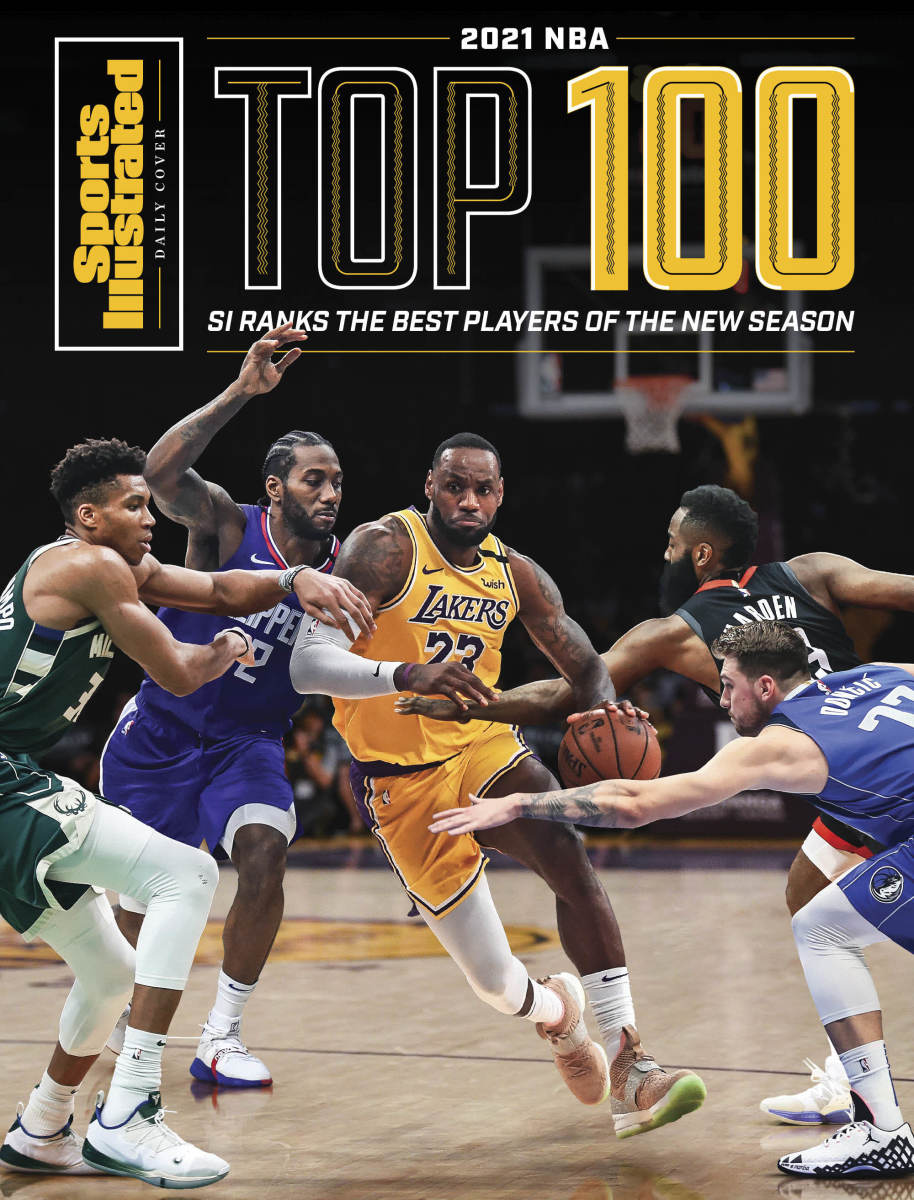
Nos. 100-51
100. Dejounte Murray, San Antonio Spurs
The Spurs are in the midst of pivoting to a new era, with DeMar DeRozan’s and LaMarcus Aldridge’s contracts set to expire after 2020–21. So who will lead San Antonio forward? Murray is likely the franchise headliner. He isn’t a prototypical point guard, but Murray’s athletic gifts are undeniable. He’s a superb on-ball defender, sporting a 6' 10" wingspan that makes life increasingly difficult for opposing guards. Murray’s ability to upsize onto larger guards provides significant value, as does his ability to wreak havoc in passing lanes. There’s a significant dose of uncertainty for San Antonio after two decades of sustained success. Murray’s defensive excellence should help stabilize the ship. His defensive value and transition prowess lands him the final spot on our Top 100, and he’ll need to improve his half-court offense to move much higher. Murray attempted fewer than two threes per game last season, and his reticence from beyond the arc isn’t an isolated statistic. He doesn’t quite explode to the rim in the half court, nor does he look to create his own shot. He’s often too content to probe and dish, limiting his scoring impact in a middling offense. Let’s hope Murray truly takes the reins of San Antonio’s offense after an underwhelming offensive campaign in 2019–20. —Michael Shapiro
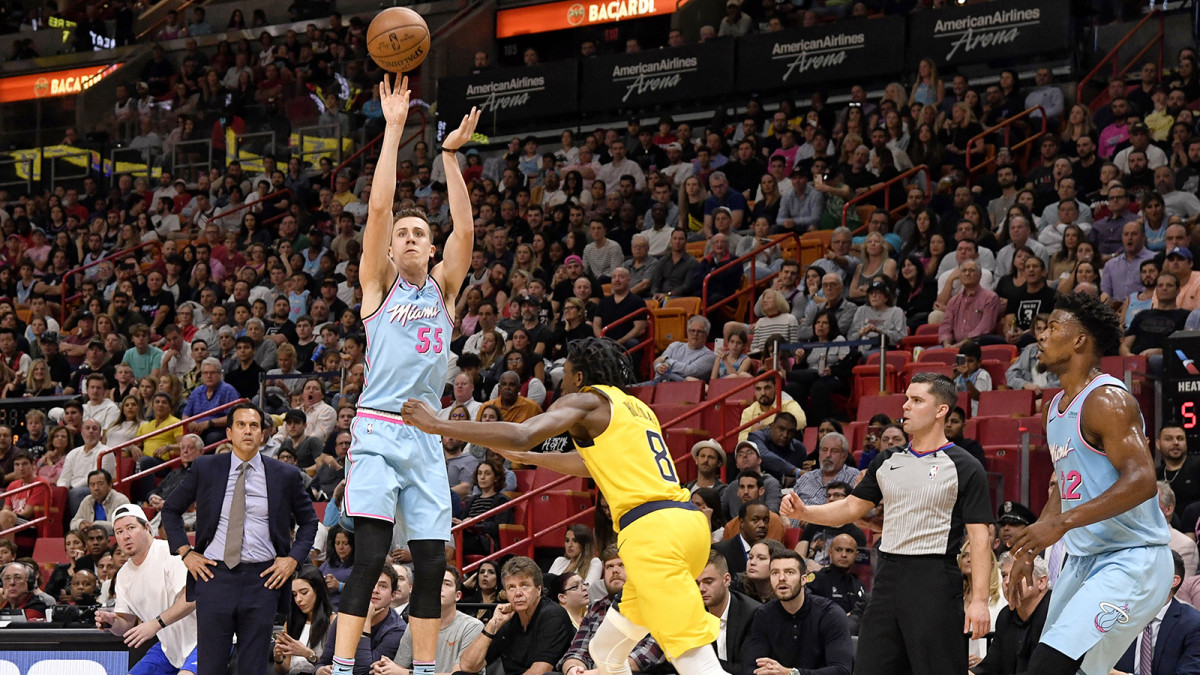
99. Duncan Robinson, Miami Heat
How important is Robinson to the Heat’s offense? When he, Jimmy Butler and Bam Adebayo shared the floor last season, Miami had an offensive rating of 115.8, practically equivalent to the all-time mark of 115.9 set by the Mavericks in 2020. Without Robinson, lineups including Butler and Adebayo could manage an offensive rating of only 108.8, which would have ranked in the bottom third of the league. Simply put, Robinson’s presence is the difference between a historic offense and a middling one. And it’s all because of the pressure he puts on defenses with his otherworldly shooting. If his breakout year doesn’t prove to be a massive fluke, Robinson will be one of the best floor spacers in NBA history. He shot 46.0% on catch-and-shoot looks in the 2019–20 season. That means his effective field goal percentage on such shots is 69%, which is higher than what LeBron James shoots on attempts within five feet. Only 26 years old, Robinson should have time to grow the other areas of his game. His defense improved throughout the playoffs, though he’ll still be targeted on that end. And his offensive game could use an extra flourish here and there, or at least one counter to teams who can doggedly chase him off the arc (as the Lakers did in the Finals.) As Robinson rounds out his game, he will continue to [ahem] shoot up this list. —Rohan Nadkarni
98. Will Barton, Denver Nuggets
One of the most impressive parts of the Nuggets’ most recent Western Conference finals run was that they won two thrilling playoff series without Barton. The 29-year-old small forward started 58 games for the Nuggets last season and was among the team’s most consistent contributors. He averaged 15.1 points and 6.3 rebounds per game, while shooting 37.5% from three and playing a multitude of roles. Simply put, he was Denver’s third-most-reliable player. Barton left the bubble on Aug. 19 with a knee injury, after playing just a single half of an Orlando scrimmage. But heading into this season, those within the Nuggets organization continue to echo his importance. “We’re not where we are without Will,” new GM Calvin Booth recently said. Barton, a former second-round pick of the Trail Blazers, was traded to Denver in the middle of the 2014–15 season as part of a deal that sent shooting guard Aaron Afflalo to Portland. And while Barton was once viewed as merely a solid wing defender off the bench, he has gone on to start 155 games for Denver, almost all of which have come in the last three seasons. It’s possible that Michael Porter Jr. might cut into Barton’s role this season, but the veteran small forward will surely be a key part of another Nuggets team with title aspirations. —Ben Pickman
97. Jonas Valančiūnas, Memphis Grizzlies
Valančiūnas isn’t earning All-NBA honors anytime soon, but Memphis’s big man remains a legitimate problem for defenses on the low block. Valančiūnas posted a 60.6 effective field goal percentage in 2019–20, averaging 0.97 points per possession on post-up attempts. The Lithuanian big man made his mark in the NBA as a skilled offensive big, though he often lacked the physicality expected from a player his size during his seven seasons in Toronto. The move to Memphis has brought out the best in Valančiūnas. He snagged a career-high 11.3 rebounds per game last season, providing a dose of brute strength next to talented youngsters Jaren Jackson Jr. and Brandon Clarke. Valančiūnas remains a key cog for the Grizzlies as they look to snap a three-year playoff drought. —M.S.
96. Patrick Beverley, Los Angeles Clippers
Three-and-D doesn’t do Patrick Beverley justice because it doesn’t account for the fact he’s a Hall of Fame pest. Beverley is one of the most relentless on-ball defenders in the NBA, and he relishes his role as someone who exists to annoy superstars and anger opposing fanbases. (He can also delight people—I distinctly remember Bill Hader got quite a kick at a Clippers game last season watching Beverley harass James Harden.) On the other end of the floor, Beverley is a career 38.1% three-point shooter, which means he’s the kind of player who can stay on the court in the highest-stakes moments. While Beverley’s on-ball tenacity, sneaky-good offensive rebounding, and capable shooting would be welcomed by any contender, his game also exists in a narrow scope. His size (perhaps generously listed at 6’1”) means he won’t be regularly used on perimeter stars. And he’s not a playmaker nor a pick-and-roll option, though he nominally functions as a point guard. These limitations hardly make Beverley a liability. But without the proper infrastructure around him (like playing with superstars), his talents wouldn’t be as pronounced. —R.N.
95. Harrison Barnes, Sacramento Kings
Harrison Barnes always felt a bit like the fifth Beatle in his time with the Warriors, and perhaps that’s led to an underwhelming evaluation of his skill set entering 2020–21. He’s viewed by many as little more than a replacement-level wing, but a closer look provides a clearer picture. Barnes may not be a standout player in any single metric. But his wide array of skills makes him a valuable player and an underrated asset. Barnes has seen his scoring drop in each of the past two seasons, but a dip in volume has correlated with perhaps the most efficient stretch of his career. Barnes posted his second best career true shooting percentage in 2019–20, and he’s one of 20 players to make more than 275 threes at a clip of over 38% in the last two seasons. Barnes isn’t solely a stationary shooter. He can attack the rim and finish with authority, and he’s evolved into a somewhat savvy playmaker. His contract may dampen his value on the trade market, but Barnes remains an effective player nearly a decade into his career. — M.S.
94. Otto Porter Jr., Chicago Bulls
Porter doesn’t exactly provide the most bang for your buck out of any player in our Top 100. He’s logged just 52 games in the last two seasons, and he’s on the books for $28 million in 2020–21. But despite an underwhelming tenure in Chicago thus far, Porter remains an intriguing piece for this season and beyond. If the Bulls find their way in the playoff chase this spring, Porter could play a crucial role. When healthy, he’s shown flashes as an elite three-and-D guy, sporting an impressive three-point stroke for a player of his size. Porter is one of just five players to shoot over 42% from three in the last four seasons (min. 400 makes), and he sports the size to defend larger forwards and the occasional big man. His fit in Chicago specifically is a bit curious. The Bulls are flush with forwards after drafting Patrick Williams, and there isn’t a deep collection of playmakers on the roster. Porter is a quality stationary wing, but he provides little off the bounce. Perhaps he can make an impact on a contender via a trade before the deadline. —M.S.
93. Dāvis Bertāns, Washington Wizards
Bertāns’s nickname, the Latvian Laser, should move him up at least a few spots on our list, but that’s an argument for another day. What’s not up for debate is Bertāns’s value as one of the league’s most effective frontcourt shooters. The fifth-year forward continues to show impressive range from beyond the arc, making a legitimate leap in 2019–20 as he nearly doubled his scoring to 15.4 points per game. Bertāns has some skill as a roll man and interior defender, but those attributes are quite ancillary to his ability to let it fly from beyond the arc. Only seven players canned more threes last season. Of the 93 players to hit 100 triples, just four posted a better percentage from three. Bertāns can stretch the floor far beyond the arc, and he has one of the quicker releases in the NBA. Washington remains on the fringe of the playoff race entering 2020–21, but they could sport one of the league’s most exciting offenses. Bertāns’s excellence remains integral to the Wizards’ attack. —M.S.
92. Derrick Favors, Utah Jazz
Simply knowing where to be at all times and never flinching is a skill unto itself. And after a year away in New Orleans, Favors returns to Utah as the league’s most overqualified backup center. Despite missing time with an injury, he finished just outside the top-10 in rebound percentage and lent defensive backbone to a team that struggled massively without him. While his mobility has waned to a degree, Favors has proven he can take away easy looks at the rim and is hardly ever out of position. He also shot a career-high 61.7% from the field, remaining among the league’s more effective finishers, capable of overpowering a mismatch when necessary. He’s also an underrated passer in the short-roll, capable of delivering the ball to either corner and greasing an offense in a pinch. Favors knows his strengths and requires minimal maintenance. It’s tough to place a premium on most bigs who present no threat to shoot from distance, and his lack of a jump shot limits his utility as such—the Jazz ought to make his minutes mutually exclusive with Rudy Gobert’s as much as possible. Situationally, there’s only so much value that can be ascribed. But Favors’s presence has long ensured a degree of reliable defensive competence, and his skills continue to age gracefully. And in a reserve role, his services are quite a luxury. —Jeremy Woo
91. T.J. Warren, Indiana Pacers
On June 20, 2019, the Suns traded Warren and the No. 32 pick in the 2019 draft to the Pacers for cash considerations. Just over a year later, Warren, who was in effect traded for cap space, emerged as one of the biggest stars of the bubble. He scored 53 points in Indiana’s opening seeding-game victory over the Sixers and followed that performance up with 34- and 32-point games over Washington and Orlando, respectively. Warren has always been a prolific scorer. He averaged 25 points per game as a sophomore at NC State, his final collegiate season, and reached double digits in his second NBA season. In each of his final two seasons with the Suns, he averaged more than 18 points per game. With Indiana last year, he recorded career-high 19.8 points per game while improving his field goal percentage from 48.6% to 53.6%. While the 6’ 8’’ Warren is by no means a lockdown defender on the wing, he also showed improvement on that end of the floor. The Pacers preached continuity this offseason and have returned the core of their roster, meaning that Warren will yet again be a key scorer for an Eastern Conference playoff hopeful. —B.P.
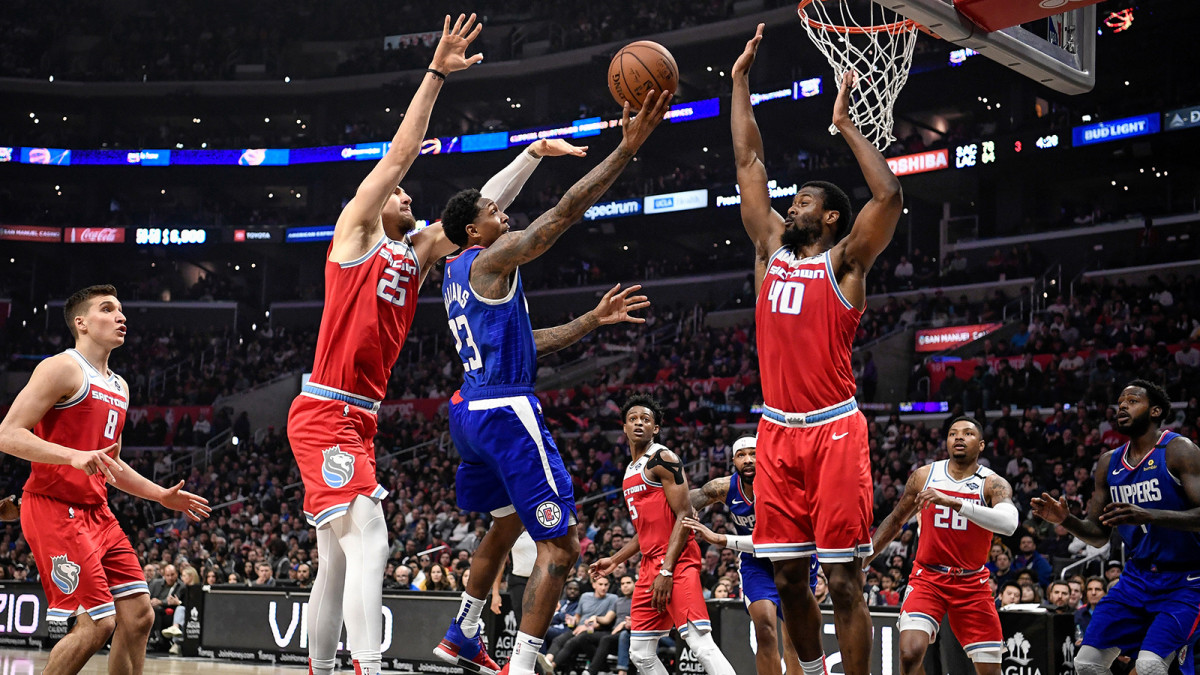
90. Lou Williams, Los Angeles Clippers
At 34 years old, Williams remains one of the most professional scorers in the league. He averaged 18.2 points per game for the Clips in 2020, playing 28.7 minutes a night off the bench. Williams can get hot at a moment’s notice, and many a coach has watched their lead slip away because of a Lou scoring barrage. With the right pick-and-roll partner, Williams can be particularly devastating, penalizing defenses who aren’t fully confident in their coverages. Efficiency is a bit of a bugaboo here, however. Williams ranked in the top five pick-and-roll ballhandlers in terms of frequency last season, but he generated only 0.92 points per possession on those plays. That number is not terrible and certainly above average, but it’s a reminder there are sometimes better looks to be had when Williams commands the offense while some of his more illustrious teammates are on the floor. Also, his size makes him an easy target on defense. All of that being said, if you are in desperate need of a bucket, you could do a lot worse than Williams. —R.N
89. Serge Ibaka, Los Angeles Clippers
Now entering his 12th NBA season, Ibaka remains one of the most versatile bigs in the league. After being used primarily as a power forward throughout the first decade of his career, including his first season in Toronto, the 31-year-old Ibaka played the majority of his minutes last year as the Raptors’ center. In doing so, he provided Toronto with a capable floor-spacer from the perimeter, shooting 38.5% from three, his best mark since 2016–17. While Ibaka might not be as much of a rim protector as he was when he was a spry 22-year-old blocking more than 3.5 shots per game, he remains a smart and more-than-capable force on the defensive end of the floor. His two-year deal with the Clippers was widely regarded as one of the most economical yet potentially impactful deals of the offseason. According to Basketball Reference, Ibaka had the highest postseason win-share of his career per 48 minutes in last year’s postseason, after averaging a postseason career-high 14.8 points per game. In joining L.A., he will similarly be expected to play a key role for a team with title aspirations, and he will bring Los Angeles much-needed frontcourt flexibility. —B.P
88. Spencer Dinwiddie, Brooklyn Nets
Dinwiddie has shown steady growth in each of first four years in Brooklyn, emerging as the Nets’ leading man in 2019–20 after Kyrie Irving’s season ended in February. Squint hard enough and Dinwiddie at times resembles Irving, though with considerably fewer acrobatics around the rim. Regardless, Dinwiddie is effective as the pick-and-roll initiator, excelling when he can drive downhill at opposing bigs. He remains outside any All-Star conversation, but Dinwiddie can be a passable engine for an NBA offense. It could be a bit of an awkward transition for Dinwiddie in 2020–21 with Irving and Kevin Durant now leading the Nets. Dinwiddie posted a career-high in usage last season, and in the games he did play with Irving, there was a palpable tug-of-war within Brooklyn’s system. But if Dinwiddie buys into his role, he could be an effective piece in a high-octane attack. Dinwiddie made 37.3% of catch-and-shoot threes last season, and he could spend a hefty share of minutes alongside Durant when Irving heads to the bench. Dinwiddie could also be in for a sizable new contract next summer if he continues his progression. —M.S.
87. Paul Millsap, Denver Nuggets
It’s undeniable that Millsap’s best NBA days are behind him, but the 35-year-old power forward still remains an important part of Denver’s roster heading into the 2020–21 NBA season. When Millsap joined the Nuggets in 2017 on a three-year, $90 million deal, he helped shepherd a young franchise into the future, culminating, thus far, in Denver’s most recent Western Conference finals run. Despite his scoring output dropping to its lowest mark since 2009–10 and his rebounding total dropping to its lowest mark since 2007–08, Millsap remains a steady defender who is capable of playing a productive, limited role on a high-quality team. The four-time All-Star recorded double-digit points four times in Denver’s thrilling Western Conference semifinals series victory over the Clippers, including tallying 17 points in Denver’s series-altering Game 5 win. He returns to Denver this season on a one-year deal, looking to help the Nuggets reach their first Finals appearance since they joined the NBA in the mid 1970s. —B.P.
86. Joe Harris, Brooklyn Nets
Brooklyn Nets team president Sean Marks recently said that small forward Joe Harris “epitomized what it means to be a Net.” The 29-year-old Harris fully resurrected his career in Brooklyn after playing just 56 games in his first two years in Cleveland. He enters this season as a starter on a perennial playoff team, having signed a fresh four-year deal worth more than $70 million. Among the 208 players who have taken at least 400 three-pointers since 2017–18, only Seth Curry has a higher three-point field goal percentage than Harris. While his three-point percentage dropped to 42.4% last season—a decrease from his league-leading 47.4% mark in 2018–2019—Harris still finished the year tied for sixth in three-point percentage. On a team that is littered with stars, Harris also appears to be more than content staying out of the public spotlight (as evidenced by being one of the few NBA players not on Twitter). After inking his new deal, the former second-round pick told reporters that he “couldn’t imagine being anywhere else.” He’ll be a key cog in the Nets’ present and future, and as the modern NBA continues to emphasize the importance of consistent three-point shooters, Harris’s value should only increase. —B.P.
85. Marc Gasol, Los Angeles Lakers
At 35, Gasol is no longer the same player he was back in the early to mid-2010s, when he anchored a Grizzlies team that was a perennial postseason threat. He still remains a valuable piece on any team he joins. While Gasol averaged 19.5 points per game in the 2016–17 season, that number dropped to a career-low 7.5 points per game last year, in his first full season with the Raptors. The Spanish center’s post-up game has diminished, but he has been more open to taking three-pointers in recent years, shooting 38.5% for Toronto in 2019–20. The former Defensive Player of the Year remains a force on that end of the court, using his high IQ and strong instincts to make an impact. As an example, he was part of all four of Toronto’s best defensive lineups that logged at least 50 minutes. “I use a lot of communication as a center,” Gasol said recently. “You’re behind them. I think communication builds trust and it solves problems.” Originally a Lakers second-round pick, he’ll finally join the franchise that drafted him after signing a two-year veteran minimum contract. L.A. had the league’s third-best defensive rating last year, behind just Milwaukee and Gasol’s old team, Toronto, and he should further solidify an already strong defensive group. —B.P.
84. Buddy Hield, Sacramento Kings
Perhaps because he plays in Sacramento, it’s gone somewhat unnoticed how downright Curry-esque Hield’s shooting has been since entering the NBA in 2016–17. Hield has the sixth-most threes in basketball over the last four seasons. Of the 16 players with at least 600 made triples in that span, Hield leads the pack in three-point percentage. The Oklahoma product shot a blistering 41.3% on catch-and-shoot triples last season. He ranked in the top 10 in pull-up threes made. Few players in the league are as talented at one specific skill. Hield may be a lethal three-point shooter, but he’s not earning All-NBA honors anytime soon. He’s not a physically imposing defender, and he’ll deliver his fair share of mental lapses on that end of the floor. Hield remains a middling playmaker, with limited skill off the bounce. Sacramento didn’t do him any favors playing at the league’s No. 20 pace last season, limiting the effectiveness of both him and De’Aaron Fox. A stylistic shift could boost both of Sacramento’s backcourt pieces in 2020–21. —M.S.
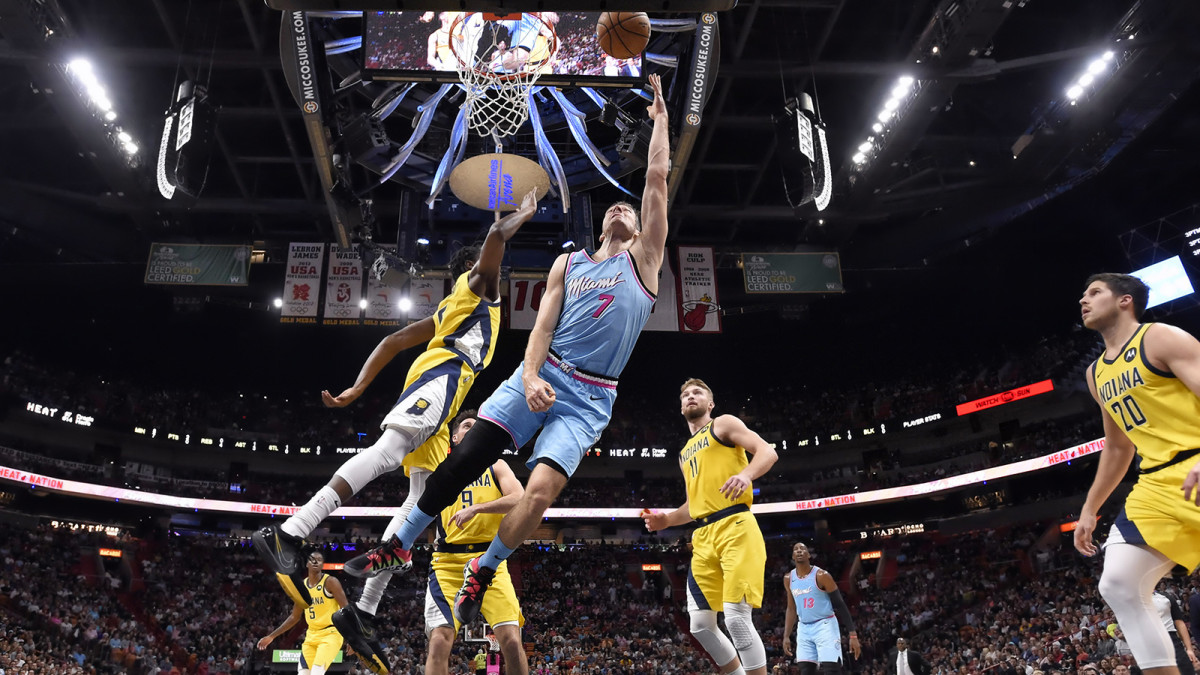
83. Goran Dragić, Miami Heat
Coming off the bench full-time for the first time since 2011, Dragić was still the Heat’s second-leading scorer in 2020. And when bumped into starting duty during the postseason, he took his game to another level, leading the team in scoring until his injury in Game 1 of the Finals. Dragić is a feisty competitor with a well-rounded offensive skill set. He’s often deadly in pick-and-rolls, adept at finding lanes against all varieties of big men. Dragić will pull up against slower footed centers who sag off him, or he’ll find a way to snake around a smaller five who wants to dance on the perimeter. He’s also a willing lob thrower, and when playing off the ball he can space the floor all around the arc thanks to his reliable shooting. Interestingly, for someone who frequently finds himself in the paint, you’d think Dragić would get to the free-throw line a touch more regularly than he currently does (4.2 attempts per game last season). And while he’s a heady team defender, Dragić can struggle at the point of attack, particularly against quick guards. Those issues are hardly dealbreakers, however, and any contending team would be happy to employ a malleable presence as Dragić. —R.N.
82. Ricky Rubio, Minnesota Timberwolves
Rubio entered the NBA as one of the most-hyped international players ever. Fans flocked to YouTube to track down clips of the dazzling Spanish star, who first appeared in Spain’s top professional league at 14 and held his own during the 2008 Olympics. The Timberwolves selected Rubio with the fifth pick in the 2009 draft. And after three seasons away from the Twin Cities, the now 30-year-old guard has returned to the franchise that initially invested in him. Rubio’s first stint with the Timberwolves was largely marred by injury as an ACL tear cut short his promising rookie season and an ankle injury derailed his 2014–15 season. But the veteran guard has nevertheless been a solid, starting-caliber player, capable of being not only a prolific passer, but also a solid defender and decent three-point shooter. Last season, while with the Suns, Rubio averaged 13 points and 8.8 assists per game while also finishing the year in the top 10 in ESPN’s real plus-minus statistic for point guards. Upon being traded to Minnesota this offseason, he admitted he was a “different player than when I came here, and when I left.” While he won’t be the star they once imagined, he’ll be a solid veteran presence for a Timberwolves team building around D’Angelo Russell and top draft pick Anthony Edwards in the backcourt. —B.P.
81. Eric Gordon, Houston Rockets
Gordon is a difficult evaluation after an injury-plagued 2019–20. Gordon underwent knee surgery in November, then battled a slate of lower-leg injuries throughout the season. When he did play, Gordon looked out of sorts. He posted the worst shooting season of his career, and Russell Westbrook’s control of the offense seemed to have a negative impact. But there’s reason to think Gordon’s dismal year was largely an outlier. With a new coach, new point guard and a clean bill of health, we should see the Gordon of old. At his best, Gordon is a perfect third guard in Houston’s offense. He’s an effective spot-up shooter with serious range, able to stretch the floor from far beyond the arc. Yet it’s not only Gordon’s shooting that makes him a valuable asset. He’s an impressive driver to the rim off the bounce, often punishing defenses who close out too hard on the perimeter. Gordon is more athletic and ferocious at the tin than his reputation suggests. His versatility gave the Warriors fits in the 2018 and 2019 playoffs. Gordon is a bit past his prime, and Houston likely regrets extending his contract. Value questions aside, Gordon remains an impactful weapon in the first year of the Stephen Silas era. —M.S.
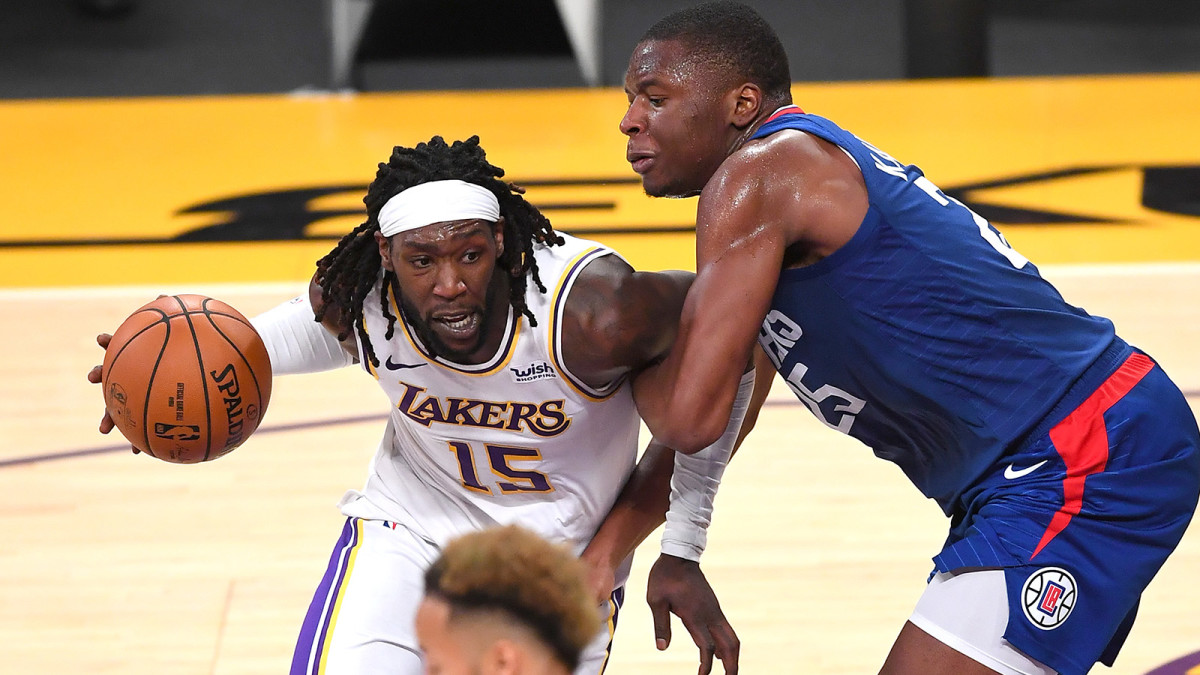
80. Montrezl Harrell, Los Angeles Lakers
The reigning Sixth Man of the Year, Harrell was the third-leading scorer on the 2020 Clippers. Now a member of the defending champion Lakers, LeBron and Anthony Davis can expect more of the same from Harrell. After initially making his name as a rim-runner with James Harden and the Rockets, Harrell has since added plenty of spice to his offensive repertoire. He’s an effective screener who has the hands to finish as a roll man. He can bully his way into favorable situations out of the post. And every now and then, he’ll also face up from the baseline and take his defender off the dribble. Put all that together, and Harrell averaged a career-best 18.6 points per game last season. The reason he isn’t higher on this list is his poor showing in the postseason, particularly his defensive struggles in the second round. Harrell is undersized as a 6’7” center, which can be an issue against skilled fives or on the glass. With Davis and Marc Gasol, the Lakers likely won’t ask Harrell to be doing as much against bigger front lines. His newest role should be his most streamlined one yet—all he has to do is keep scoring. —R.N.
79. Jerami Grant, Detroit Pistons
Jerami Grant enters the season as one of the most interesting players to watch throughout the league. After playing 26.6 minutes per game largely as a reserve with the Nuggets, the versatile forward signed a three-year, $60 million deal with the Pistons this offseason. According to the Denver Post’s Mike Singer, the Nuggets vowed to work with Grant and develop him more as a player, even offering him a similar deal. Nuggets president of basketball operations Tim Connelly later said publicly that the team was “under the assumption we would get something done.” But Pistons first-year general manager Troy Weaver said Grant was their top priority, and Grant said at his introductory Pistons press conference that the challenge of Detroit “intrigued” him. The 26-year-old will look to become a more complete player with the Pistons. He has proved to be a versatile defender and has shot nearly 40% from three in each of his past two seasons. However, it remains to be seen whether the former second-round pick can grow into a go-to scorer or merely a solid role player for years to come. —B.P.
78. Joe Ingles, Utah Jazz
Despite losing in the first-round of last year’s postseason, the Jazz are again banking on roster continuity to pay dividends. Among the players expected to contribute in important roles is Ingles. The 33-year-old forward started just 45 games in 2019–20, his lowest total since his third year with the franchise, and he at times struggled to adjust back to a reserve role after becoming an every-night starter in 2017–18 and 2018–19. But he enters this season still playing the role of an essential secondary creator who won’t overstep his ability. Ingles shot 39.9% from three last season and was a steadying defensive presence for a Utah team that went 44–28. In the postseason, the 6’7’’ Australian saw his minutes increase even though he struggled, by his standards, in Utah’s lone playoff series, shooting just 35% from deep. There is little uncertainty to Ingles’s game, and he remains a crafty perimeter player any winning team would want to have. —B.P.
77. Gary Harris, Denver Nuggets
Will the real Gary Harris please stand up? A frustrating run of injuries has limited his availability the past two seasons, and his efficiency has dipped. But Harris is still just 26, and the established value of his skill set bodes well. His penchant for cutting and spotting up and his embrace of difficult matchups on the other end of the ball allow him to fit in with just about anyone. With the Nuggets’ most potent lineups likely to include Nikola Jokić, Jamal Murray and Michael Porter together, Harris’s feel for complementing others, limiting mistakes and making plays in a pinch has never been more critical. It’s one thing to find a player who’s willing to fit in, but another entirely when the crux of his game is so well suited for just that. The thought he might become Denver’s third star has subsided, but if clean health and renewed confidence are in the cards, Harris’s shooting percentages ought to trend back upward, adding the requisite punch that would return him to form. A thorough understanding of Harris’s value has always been best obtained by watching closely, not poring over his numbers. —J.W.
76. Bogdan Bogdanović, Atlanta Hawks
The Hawks shelled out $72 million for Bogdanović in the offseason, and his offensive skill set should make the contract a worthwhile play for Atlanta. Bogdanović projects to be an idyllic backcourt mate for Trae Young, sporting a 40.7% mark on catch-and-shoot triples in 2019–20. Bogdanović is a quality spacer, but perhaps more importantly, he sports the playmaking ability to take some share of the offense from Young. Atlanta’s franchise cornerstone is an immensely gifted offensive player, but the Hawks’ offense stalled at times as Young dominated possession after possession. Some balance should help both Young and the team’s development in 2020–21. Bogdanović also provides more than what you see on the stat sheet. He has a reputation as a fierce competitor and intense personality, and he provides important size in the backcourt alongside the diminutive Young. Atlanta has its eyes set on the playoffs in 2021. Adding Bogdanović was a major step toward making that happen. — M.S.
75. Zach LaVine, Chicago Bulls
Volume scorers are perhaps the trickiest players to place in an exercise like this, and there may be no better example than LaVine, who placed 11th in the league with a career-high 25.5 points per game. As he’s matured, he’s curtailed some of his mid-range proclivities in favor of more threes and rim attempts, which has been a step in the right direction. Doing what he’s done is not an easy task, and capable shot-creators with his size and explosiveness are few and far between. Whether his preferred style of play—which has never involved much defense—can run conducive to team success is still the question hanging over his real value. He’s not an elite jump shooter or play finisher, nor is he a free-throw-drawing monster, and creating for others has never been a major piece of his identity, either. If he’s stretched himself to his limits putting the ball in the basket, LaVine will need to evolve in a different direction to make the most of his considerable ability. He remains one of the most impressive athletes in the NBA, and his ability to create for himself could still be meaningful to a winning team. His prime years may be defined by his capacity to adjust. —J.W.
74. Deandre Ayton, Phoenix Suns
There were reasons for caution regarding Ayton’s outlook early in his career. His efficient rookie season was marred by a lack of physicality and defensive intensity, and he started out 2019–20 with a 25-game PED suspension. But Ayton’s 38-game sample last season should provide significant optimism for the young center’s future. Ayton is one of the game’s most skilled young centers, and with him flanked by two All-Star guards, a monster 2020–21 could be in store. Ayton’s offensive skills jump off the screen in a variety of ways. He sports a soft touch near the rim and around the foul line, and he’s a prodigious force in the pick-and-roll. Ayton averaged 1.16 points per roll possession last season. He shot nearly 55% from the field. There’s still growth to be had on the defensive end, but those problems should be solved with added experience. With Chris Paul now in the fold, Ayton could very well rocket up our Top 100 entering 2021–22. — M.S.
73. OG Anunoby, Toronto Raptors
With Kawhi Leonard and Danny Green no longer in Toronto, Anunoby was thrust into a starting role last season, and he excelled. Anunoby is kind of the platonic ideal of a three-and-D guy. He shot 39.0% from behind the arc in 2020 and played stellar defense on the other end of the floor. At 6’ 7”, Anunoby is perfect for the modern NBA because of his ability to guard multiple positions and allow for lineup flexibility. The Raptors maintained their championship-level defense last year despite the high-profile departures, and that was in large part because Anunoby was ready for the responsibility of matching up with talented wings. While he may not be a pure shutdown defender just yet, OG has all the tools to enter the upper echelon of stoppers, and he’s already giving people trouble. His athleticism gives his offense a little bit of bounce as well. He doesn’t have to be a pure catch-and-shoot guy, though getting his three-point attempts up would be a welcome sight. With Marc Gasol and Serge Ibaka now gone as well, the Raptors are well removed from their 2019 championship squad. Expect an even bigger role for Anunoby moving forward. — R.N.
72. Brook Lopez, Milwaukee Bucks
It’s quite possible Lopez exemplifies the shift in the role of the modern big man better than any other player in the league. Throughout his first six NBA seasons with the Nets, he took just seven total three-pointers. But in 2016–17, he fired 387 threes, up from 14 total the year prior. Lopez saw his three-point percentage drop from 36.5% to 31.4% last season, his second in Milwaukee. However, he remained an ideal stretch five who frequently stepped out on the perimeter, but was still able to punish smaller defenders around the rim. The 32-year-old center also has evolved into a centerpiece of Milwaukee’s league-best defense, finishing fifth overall in ESPN’s real plus-minus for centers last year and third in defensive real plus-minus. While Lopez played just 26.7 minutes per game in the regular season, his minutes increased to 32.8 per game in the playoffs. Expect a similar trend this season with the team looking to make its first finals appearance since the 1973–74 season. —B.P.
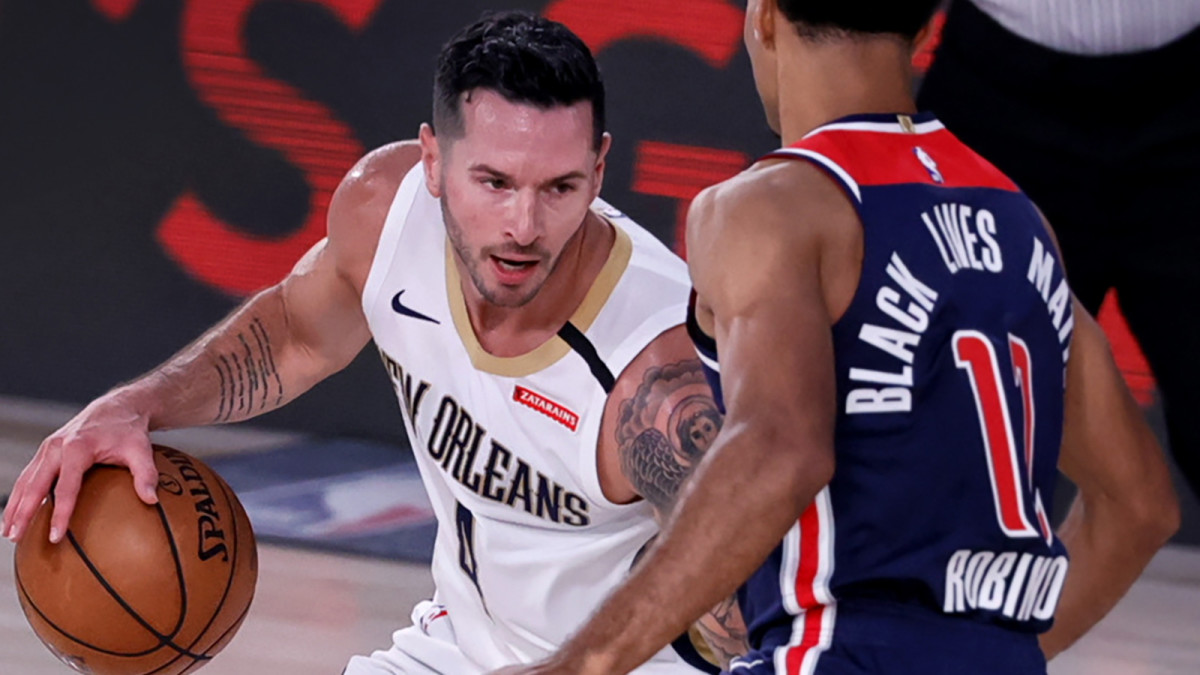
71. JJ Redick, New Orleans Pelicans
Don’t be fooled by the quantity of podcasts, entering his 15th season, Redick remains one of the most accomplished marksmen in the Association. In his first season with the Pelicans, the veteran had the second-best three-point shooting mark of his career, connecting on 45.3% of his attempts from beyond the arc. If anything, Redick was slightly underutilized on a young New Orleans team, playing his fewest minutes per game (26.4) since 2011. Redick offers space as soon as he steps on the floor, and his conditioning at age 36 should be commended. His constant movement generates open looks despite the undivided attention of his defender. While Redick’s own defense isn’t sterling—the Pels were 3.7 points per 100 possessions better defensively with Redick off the floor—he’s still more than capable of staying on the court in high leverage moments, the key test for any specialist. Of course, while he has acquired a particular set of skills over a long career that can make him a nightmare for opponents, Redick’s narrow scope means he’s at his most valuable on a team already studded with stars. Whether or not Redick is in the perfect role for himself on an up-and-comer, he should continue to provide some much-needed room for Zion Williamson and Brandon Ingram through 2021. —R.N
70. P.J. Tucker, Houston Rockets
James Harden has transformed the Rockets franchise over the last decade, but P.J. Tucker remains Houston’s heartbeat. Since the start of the 2012-13 season, he has played the most games (637) of any player in the league and even entering his age-36 season, Tucker is an elite defensive force. Only the game’s truest behemoths can gain an inch on Tucker in the post. Few guards can skate by him on an island. Houston’s switch-everything scheme in prior years would have been rendered completely ineffective without Tucker’s presence. He has his limits offensively, but finds a way to provide value on that end of the floor. He’s become one of the league’s most effective corner-three specialists, and he’s developed a canny floater in recent years. Tucker’s smarts and versatility have made him an invaluable cog in Houston over the last three seasons, and until further notice. —M.S.
69. Clint Capela, Atlanta Hawks
Capela is the forgotten man in Atlanta’s rotation after the Hawks’ offseason makeover. Much of the focus has been on the acquisitions of Bogdan Bogdanović and Danilo Gallinari, but the Hawks should have a marked upgrade at center as well in 2020–21. Capela isn’t in the top tier of centers—largely due to his limited offensive skill set—though when healthy, he can truly be a dominant interior force. Capela may in essence function as Atlanta’s most important addition. The former Rockets center is a gifted athlete. He’s a quality lob threat, and more importantly, he can hold his own on an island with wings and guards. Capela is at his best in transition. He feasted on free dunks off James Harden outlets in Houston, beating the likes of Joel Embiid and Nikola Jokić down the floor time and again. If Atlanta relies on a quick tempo in 2020–21, Capela could truly thrive. —M.S.
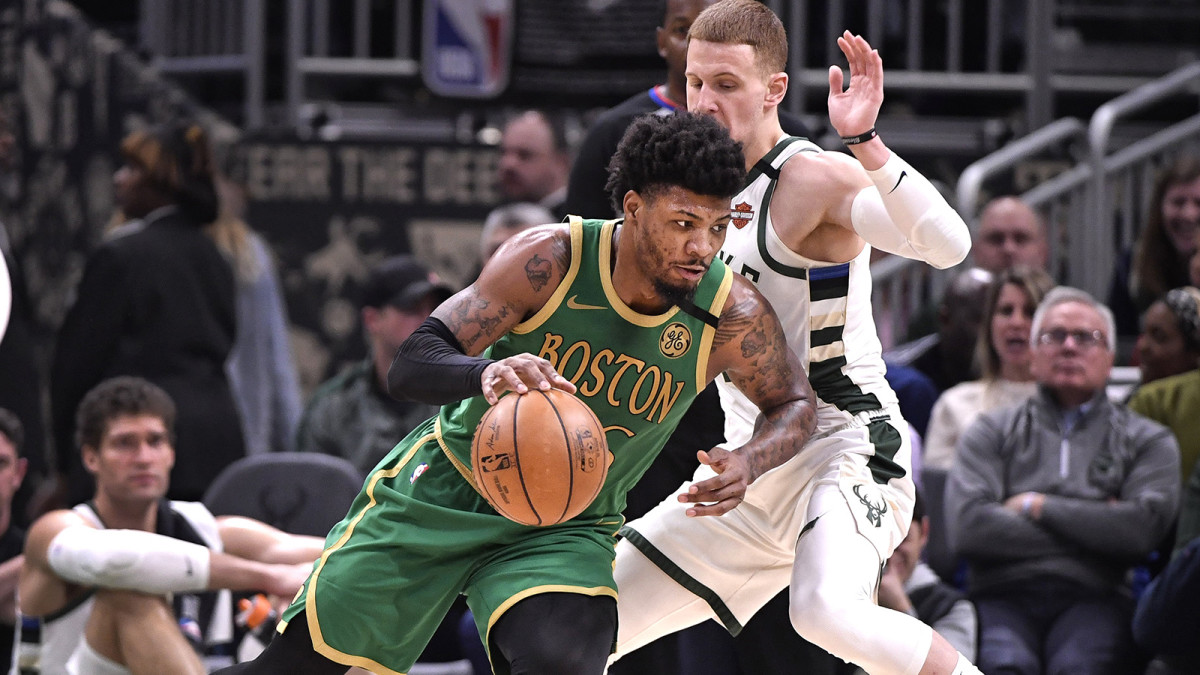
68. Marcus Smart, Boston Celtics
It’s possible Smart’s career-best 2018–19 season—when he appeared to take a step forward as a scorer—was something of a mirage in terms of shooting. But if he’s proved one thing over the years, it’s that there’s a method behind his unique brand of chaotic good. Smart is an energy-giver in a way that few, if any, of his peers can truly match, flying around defensively to create stops, occasionally catching fire from distance, and ratcheting up the intensity level of a given moment. He’ll never be the king of efficiency, but he’s fashioned himself into a more reliable jump shooter over the years. Smart doesn’t always take care, but he always cares, sometimes more than he should, always for the right reasons. There will be nights he struggles to find the net, and others where one or two particularly inspired Smart shifts can swing the outcome of a game. He’s become an indispensable piece of one of the NBA’s better teams, and he’s earned first-team all-defense honors in consecutive years. And in an exercise like this that attempts to remove players from their contexts, his situational worth to the Celtics might even be slightly undersold. —J.W.
67. Eric Bledsoe, New Orleans Pelicans
The Pelicans come into this season as one of the NBA’s most intriguing teams, with a number of high-upside young players, recently acquired veterans and a new coaching staff eager to lead them to the postseason. Among those vets is Bledsoe, who joins New Orleans after nearly three full seasons with the Bucks. At times, he looked like a potential franchise centerpiece and All-Star-caliber guard alongside Giannis Antetokounmpo and Khris Middleton. Other times, the Kentucky product looked lost and unable to snap out of various funks. Bledsoe provides the Pelicans with defensive physicality and will certainly help orchestrate New Orleans’ offense, anchored by Brandon Ingram and Zion Williamson. But much of Bledsoe’s reputation has been defined by his playoff struggles, having shot just 25% from three-point range in last year’s postseason and just 23.6% from deep in the 2018–19 playoffs. He certainly won’t have the same spotlight on him in New Orleans that he did in Milwaukee, and as a result, maybe he flourishes for a team with more modest aspirations. He remains a difficult player to stop in transition and a solid rebounder, especially for a guard who is just 6’1’’. It’s unlikely he’ll ever make an All-Star team, but don’t be surprised if he looks more like the guard that averaged more than 20 points per game in Phoenix. —B.P.
66. Robert Covington, Portland Trail Blazers
Covington is largely an ideal three-and-D forward, especially on the defensive end. The Tennessee State product can legitimately defend both guards and larger wings, excelling as a weak-side helper. Only two players tallied more steals in 2019–20. Just nine finished with more blocks. Covington should continue to be a valuable defensive asset in Portland, where he’ll excel as a versatile frontcourt piece alongside Jusuf Nurkić and Derrick Jones Jr. Covington should help the Blazers secure a playoff spot in an increasingly crowded West. There are some offensive shortcomings to note with Covington. He’s more of a stationary shooter than anything on the offensive end, and his jumper ebbs and flows more than one would like. Covington struggled mightily from three in the NBA bubble, and while that may be a small sample, he’s never been a truly knockdown shooter. Perhaps playing alongside Damian Lillard and CJ McCollum will generate more wide-open looks in 2020–21. —M.S.
65. Al Horford, Oklahoma City Thunder
Horford has taken a relative tumble in his reputation across the league after an ill-fated stint in Philadelphia, but the five-time All-Star should be a stabilizing force for a young Oklahoma City team in 2020–21. Horford was relegated to spacer status alongside Joel Embiid in Philadelphia, zapping him of his best skills as an offensive player. Horford is a terrific interior passer and effective pick-and-roll partner. It’s easy to see him forming a quick rapport with Shai Gilgeous-Alexander, who is additionally crafty in the two-man game. Horford’s intelligence could have an effect similar to Chris Paul’s in Oklahoma City, though it’s unlikely to be truly reflected in the standings. For a team now deep into its rebuild, Horford provides professionalism and competence. He should be better in 2020–21 than he was in his final year in Philadelphia. —M.S.
64. Jaren Jackson Jr., Memphis Grizzlies
Memphis’s future is bright after a string of lottery appearances, and not solely because of Ja Morant. Jaren Jackson Jr. and Brandon Clarke are two of the Western Conference’s more exciting young forwards, looking like a potential top three in the years to come. A little lottery luck has gone a long way, leading to plenty of optimism surrounding Taylor Jenkins’ squad. Jackson shined in his second NBA season, making a significant leap as a three-point shooter. The Michigan State product shot 39.4% from beyond the arc on 6.5 attempts per game, more than LeBron James, Jaylen Brown and Joe Harris. And Jackson’s skill isn’t solely tied to his value from three. He averaged 1.24 points per roll possession, sporting comparable numbers to Rudy Gobert and Bam Adebayo. He’s foul-prone, but a versatile defender, who should be even better on that end as he gets stronger. Morant has a pair of true weapons in the frontcourt, headlined by the former Spartan. —M.S.
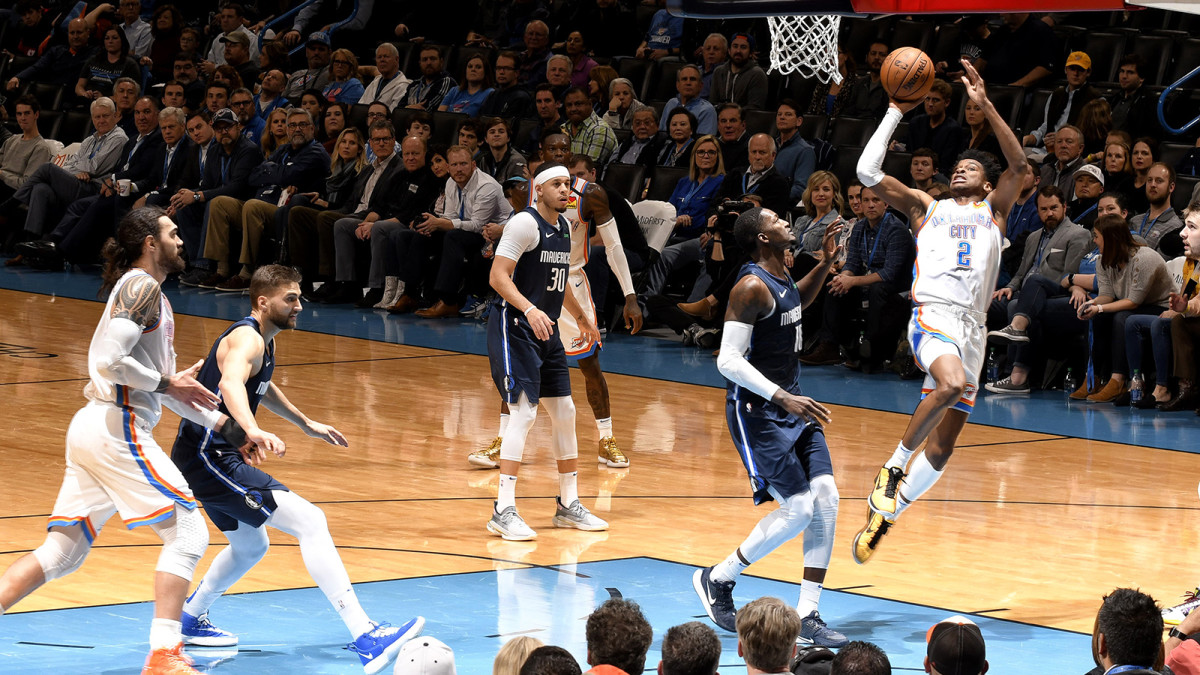
63. Shai Gilgeous-Alexander, Oklahoma City Thunder
The Thunder’s premeditated decision to tear down a longtime playoff team came with Gilgeous-Alexander’s best long-term interests in mind. He makes his Top 100 debut on the cusp of stardom, and with another step forward in his development, this ranking may end up looking unnecessarily patient. There are few guards anywhere who check as many crucial, creative boxes: He handles with an unpredictable cadence, he’s dangerous in ball screens, boasts catch-and-shoot chops, and can lean on a reliable in-between game when he can’t get to the rim. At 22 years old—and standing 6’ 5”—Gilgeous-Alexander has displayed prodigious comfort in all those areas. He’s good at pretty much everything already, and in his third season will inherit a heavy on-ball workload for the first time, with shooters around him. The big unknowns are to what degree he can amplify his playmaking skills (in two seasons as more of a secondary handler, his assist-to-turnover ratio is a respectable 1.8), and just how dangerous he’ll become shooting from distance. Defenses will consistently key on him for the first time, and he’ll be tested. But based on all we’ve seen, it feels like a simple matter of time before his next meaningful leap. —J.W.
62. Caris LeVert, Brooklyn Nets
For a player who has yet to make an All-Star team, Nets guard LeVert has been one of the most talked about players in the league. He’s shown improvement in each of his four seasons, tallying career highs in points (18.7), rebounds (4.2), assists (4.4), three-point shooting (36.4%) and minutes (29.6) per game last season. But the question remains whether he’s merely a high-quality secondary option or whether he could lead a team on a daily basis, and in turn, whether he could be the centerpiece of a trade for another star. This summer, LeVert shed some light on that question, leading the shorthanded Nets to a 5–3 record as he moved from a secondary scorer to a primary ballhandler and scoring role in the bubble. And while the Raptors discharged the Nets in four games, the 6' 6" guard averaged 20.5 points and 9.5 assists per contest on 18 shots per game. LeVert admitted during media week that he’s heard the noise around his name in rumors, but said that team general manager Sean Marks has been an “open book” in terms of keeping the 26-year-old informed. “Whatever happens, it was meant to be,” LeVert said recently. Maybe he’ll become the Nets’ true third star alongside Kevin Durant and Kyrie Irving, or maybe he’ll get moved. Either way, LeVert has shown steady improvement throughout his career, and has a strong foundation to build off. —B.P.

61. Aaron Gordon, Orlando Magic
Is Gordon still an up-and-coming player, or has he hit his ceiling? It’s a question that remains tough to definitively answer, and one that can similarly be asked about the Magic. Still just 25 years old, Gordon averaged 14.4 points on just over 12 shots per game last season, down from the past two. He remains a versatile forward capable of guarding four positions if needed, but it also appears clear with every season that he’ll never be more than an average three-point shooter, thus limiting his offensive ceiling. Gordon still flashes glimpses that remind people of Blake Griffin, Draymond Green and Pascal Siakam, but there are other times he looks like he’d be better suited as a secondary or tertiary option. Gordon is no doubt a capable player, but with unrestricted free agency two full seasons away, more clarity about his future—or how teams value him—will come sooner than later. —B.P.
60. Myles Turner, Indiana Pacers
Boston appeared to pass on taking Turner in a potential Gordon Hayward sign-and-trade, perhaps a questionable decision given Turner’s impressive talent. Though he isn’t exactly a brick wall on the low block, he’s established himself as an elite weak-side shot blocker, with 2.1 blocks per game in 2019–20. Turner adds impressive stretch capability from beyond the arc as well, canning 37% of threes on 446 attempts over the last two seasons. Turner is a malleable offensive piece for the modern game. He’s likely worth the $52.5 million owed over the next three years. Turner provides quality versatility, but his offensive skill set does leave something to be desired at times. He doesn’t pair his range with any real physicality, and he’s not exactly quick enough to beat bigs off the dribble when they chase him onto the arc. Turner is a bit of a stationary shooter, albeit a quality one. His age and shot profile suggests he can be an impactful force for years to come. But without further offensive development, there is likely a ceiling on Turner’s potential. —M.S.
59. John Collins, Atlanta Hawks
Atlanta gave its roster a major makeover ahead of 2020-21, shelling out nine figures for Bogdan Bogdanović and Danilo Gallinari in a push to reach the postseason. The pair of free-agent signings will be joined by frontcourt newcomers Clint Capela and Onyeka Okongwu, creating a short-term logjam. But the added pieces won’t cut into Collins’s production as much as one may think. The Wake Forest has been a prodigious offensive force and will be a part of unlocking Atlanta’s tantalizing ceiling. Collins is an ideal frontcourt player alongside Trae Young, at least on the offensive end. His evolving jumper—40.1 percent from three in 2019–20—creates legitimate spacing in pick-and-pop scenarios, and Collins is downright lethal as a roll man. He averaged 1.31 points per roll possession last season, posting a better mark than Anthony Davis, Bam Adebayo and Rudy Gobert. Collins can put the ball on the floor in tight spaces, and he’s an elite leaper at the rim. You can quibble with his defensive shortcomings, as well as his lack of a true position at 6' 9". But Collins’s offensive skills are undeniable. He should command a nine-figure contract next summer, even if he moves on from Atlanta. —M.S.
58. Andre Drummond, Cleveland Cavaliers
The Cavaliers acquired Drummond last February in a surprising, but relatively low-risk deal that sent Brandon Knight, John Henson and a 2023 second-round pick back to Detroit. The bruising center played eight games with the Cavaliers, who later picked up his $28 million player option. While pricey, Drummond would appear to be more of a short-term option for a rebuilding team. He’ll get the opportunity to try and mesh with All-Star forward Kevin Love in the Cavs’ frontcourt as the franchise looks to develop lottery picks Collin Sexton, Darius Garland and Isaac Okoro alongside them. Drummond is still a rebound eater, having led the league in each of the past three seasons. He is also a force around the rim, scoring the third-most paint points per game in the league (10.8). Cleveland finished last season with the league’s second-worst defense, and a full season of Drummond should also help improve those numbers, if only marginally. He said recently that his plan this offseason was “always to come back to Cleveland.” The two-time All-Star remains a high-quality player, but for better or worse, he’s still a stat stuffer on a young team. —B.P.
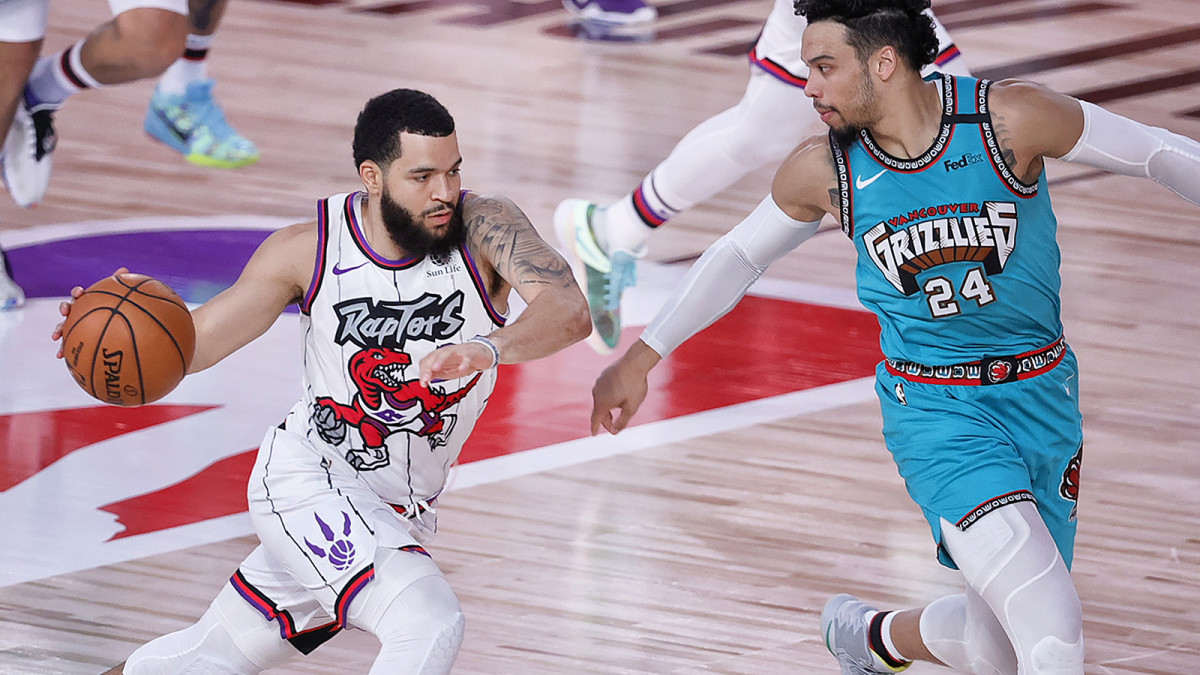
57. Fred VanVleet, Toronto Raptors
Yet another Raptor who stepped up in the wake of Kawhi's walking away, VanVleet posted career numbers practically across the board in 2019–20. The 26-year-old recorded personal bests in points, assists, rebounds, minutes, free throw attempts and three-pointers made per game. FVV excelled in a bigger role, also commanding chief ball-handling duties when Kyle Lowry missed time with injuries. VanVleet is dubiously listed at 6' 0", but makes up for his size by frequently barreling his way into the paint and collapsing the defense. He’s also long been a knockdown shooter, and he hit 39% of his threes last year while increasing his volume significantly. And he’s just as proficient on the defensive end. VanVleet’s defense at the point of attack is sterling. Watching him and Lowry hound opposing guards well above the three-point line is thoroughly entertaining. In the conference semifinals, Boston’s offense struggled mightily in the half court, in large part because of VanVleet’s ability to fight over screens and cut off lanes to the paint.
Toronto will probably need even more from VanVleet this upcoming season. The departure of Marc Gasol takes away a halfcourt creator. Can VanVleet lead the team in assists? Can he lead the team in scoring? After signing a four-year, $85 million contract in the offseason—and with Lowry on an expiring deal—it’s clear VanVleet is a cornerstone of the Raptors’ future. There’s certainly room for improvement here, like finishing at the rim or bumping up his percentage on pull-up threes. Considering VanVleet’s path to this season—entering the league as an undrafted free agent, proving he could stick, then starring in a Finals against Stephen Curry—the Raptors should be confident he can continue to grow. —R.N.
56. Bojan Bogdanović Utah Jazz
Bogdanović made a name for himself in the NBA as an effective three-point shooter, but the six-year veteran is a significantly more versatile offensive option than he’s been given credit for. Donovan Mitchell remains the headliner in Utah, and Rudy Gobert could very well earn a $200 million deal next offseason. While the Jazz are anchored by those stars, Bogdanović remains an indispensable piece. We’d be remiss not to mention his elite shooting in recent seasons. He is one of six players with at least 500 threes at over 40% over the last three seasons, and his range extends multiple feet beyond the arc. Utah often faces clogged lanes due to the presence of Gobert. Bogdanović’s considerable floor-spacing threat helps alleviate that issue. He also provides valuable scoring off the bounce, which is critical for a Utah offense that at times appears stuck in mud. It’s not blazing speed that fuels him, but rather an innate feel for the other nine players on the floor. Bogdanovic can slither around a Gobert pick en route to the rim. He can pump-fake his way past a defender for a two-dribble pull-up. It’s not the most aesthetically thrilling game, but he can light up the scoreboard in a hurry. Utah is often better than the sum of its parts given the roster’s offensive shortcomings. Bogdanovic’s presence is key to unlocking the Jazz’s attack. —M.S.
55. Domantas Sabonis, Indiana Pacers
Though he’s not quite a household name, Sabonis comes into this season looking to build on a breakout 2019–20 campaign. The versatile big played 34.8 minutes per game last season, setting career highs for points (18.5), rebounds (12.4) and assists (5.0) per game. His arsenal features a throwback post-up game, and he’s already a prolific screener and passer, throwing the third-most passes per game in the league last year. Indiana is now led by first-year coach Nate Bjorkgren, who has already publicly marveled at Sabonis’s ability. “From Domas being able to just put so much pressure on the rim,” Bjorkgren said, “I just know coaching against him in the past, his ability to screen and dive hard and how physical he is.” He made his first All-Star team last year, and with Victor Oladipo’s and Myles Turner’s long-term futures with the Pacers uncertain, Sabonis appears to be one of the franchise’s centerpieces. The 24-year-old was missed in last year’s postseason, and Indiana was subsequently swept for the third time in four years. If the Pacers want to remain among the conference’s top teams, a lot will be riding on the shoulders of their budding star. —B.P.
54. Malcolm Brogdon, Indiana Pacers
It’s hard to separate Brogdon from his frontcourt partner, Domantas Sabonis, hence their adjacent placement on this list. The two displayed an almost immediate chemistry in pick-and-roll situations last year, Brogdon’s first with the franchise. The 6' 5" Brogdon is the epitome of a combo guard, fully able to play either an on-ball or off-ball role. He averaged 16.5 points and 7.1 assists in 2019–20 and will again play a central role in orchestrating a Pacers attack that features not only Sabonis, but also T.J. Warren, Myles Turner and Victor Oladipo. How Brogdon will fit alongside Oladipo is among Indiana’s biggest questions heading into this season. Brogdon also saw his three-point shooting slip from 42.6% in 2018–19, his last year with Milwaukee, to just 32.6% with the Pacers. But the crafty Brogdon has outperformed expectations throughout the entirety of his career, and seems poised for a return to form with more help around him. —B.P.
53. Gordon Hayward, Charlotte Hornets
Hayward’s ill-fated Boston tenure has diminished his perceived value across the league, but despite some dampened athleticism, he joins the Hornets as a still-impactful offensive force. Hayward is a quality shooter, to be sure, but that’s arguably the least impressive element of his dynamic skill set. Hayward sports the instincts of a point guard. He’s quick to advance the ball up the floor in transition, and he’s an expert at skipping the ball from the wing to the opposite corner with either hand. Hayward also excels snaking in and out of the pick-and-roll, able to keep defenders on his hip before contorting his body around bigs around the rim. Don’t let his injury history obscure his offensive value. He was relegated to secondary scorer status in Boston, spending most nights as a spot-up specialist, but could see a relative career revival in Charlotte. Hayward can dictate much of the offense alongside LaMalo Ball, and we could even see a sneaky two-man game develop between them. Charlotte would be smart to increase its pace with Hayward and Ball, capitalizing on each player’s vision and skill in the open court. Is $120 million too rich for Hayward? Perhaps. But he should still make a marked impact with the given good health in 2020–21. —M.S.
52. Tobias Harris, Philadelphia 76ers
Harris has emerged as an effective three-point shooter in recent seasons, canning 39.3% of triples over the last three seasons on fairly significant volume. But forcing Harris to largely stand on the perimeter seems to be an underutilization of his skills. He sports a smooth jumper off the bounce, and while he’s not the most explosive leaper, he’s one of the league’s more creative finishers for a player of his size. Harris’s first two years in Philadelphia have been marred by a misuse of his talents, but Brett Brown shouldn’t be completely excoriated. Philadelphia is led by a behemoth center and a point guard without any discernible jump shot, and last year’s roster featured a stunning lack of shooters. Harris was often the lone spot-up option on the floor. Doc Rivers’s tenure should be different. Seth Curry will open up the floor to a significant degree. Simmons should take at least a small step forward with his shot. Let’s hope Harris earns a greater share of playmaking duties in 2020–21, allowing his impressive offensive arsenal to shine. —M.S.
51. John Wall, Houston Rockets
Placing Wall in the point guard hierarchy as he returns from multiple serious injuries in his left leg, including a torn Achilles, is a precarious exercise. He returns to the Top 100 as a member of the Rockets, having missed the better part of the last three seasons and trying to regain his footing. Wall is purportedly close to full strength, but a scary question hangs over what remains of his prime years: What happens if the fastest player in the NBA loses any meaningful amount of the interplanetary burst that made him great? Of course, Wall is a terrific passer, but his ability to stretch defenses in transition has always played a role in his gaudy assist totals. He’s always been ball-dominant, and his three-point shooting has rarely been far above average, with his 37% clip over 41 games in 2017–18 looking like an outlier. Wall now joins a Houston team in a role that will stretch the limits of his skill set, as a defined second star alongside the NBA’s usage god himself, James Harden. Even if he looks like his old self, he’ll be asked to mesh in a way he never has before, spotting up, cutting and making himself useful when the ball isn’t in his hands. If the reports about his return to form are accurate, Wall should make this ranking look foolish. But as he hits the other side of 30, his checkered health history, volatile shooting splits, and limited versatility are inseparable from the value conversation. —J.W.
Nos. 50-31
50. Mike Conley, Utah Jazz
Conley got off to a rocky start in Utah, adjusting alongside another ball-dominant guard in Donovan Mitchell and appearing in just 47 games due to injuries. By February and March, his play had returned to his usual standard, and he was mostly effective in the bubble, assuaging concerns that his performance level was anywhere close to cratering. Now 33, he remains one of the league’s more calming forces, historically great at limiting turnovers, reading the floor and knowing where the ball should be at any given time. Between some inevitable physical decline, his limited impact on defense and a drop in efficiency, there’s some slight regression taking place. But the tenets of Conley’s game—heady play, dangerous jump shooting, and comfort under pressure—remain sharp as ever. He may not be the piece that gets the Jazz over the hump, but a second full season, health pending, will offer a far better sense of what he has left in the tank. As the third wheel on a well-built team, with a heightened comfort level, Conley is poised to bounce back in a meaningful way. —J.W.
49. Danilo Gallinari, Atlanta Hawks
The addition of top free agent Gallinari will surely boost a Hawks team that went 20–47 last season. Whether starting or coming off the bench, the 32-year-old remains a high-quality piece, providing his team with a mix of perimeter shooting and fairly versatile defending. While he hasn’t played more than 70 games in a season since 2012–13, Gallinari was a solid contributor for the Thunder last year, averaging 18.7 points, 5.2 rebounds and 1.9 assists while averaging less than 30 minutes of action. A 40.5% shooter from three, Gallinari will help the Hawks on the perimeter, as Atlanta was the league’s worst three-point shooting team last season. He will also pair nicely with Trae Young, having shot nearly 42% on catch-and-shoot threes last year. While Gallinari’s three-year, reported $61.5 million contract might be a little steep of a bill to pay—it’s the largest multi-year contract ever for a player older than 30 who has never made an All-Star team—he should make a Hawks roster loaded with young talent more competitive in the short term. —B.P.
48. Steven Adams, New Orleans Pelicans
While Adams rarely gets full credit for his services, he remains a king of positional nuance and, of course, a man of prodigious strength. He anchored playoff-caliber Thunder defenses for five straight seasons, regularly finishes among the NBA’s leaders in screen assists and offensive rebounds and occupies an unusually large amount of precious space around the rim. He doesn’t block a ton of shots. His presence dissuades all but the most daring drivers from approaching. Adams doesn’t shoot jumpers, but he frees teammates for open ones with well-angled, incidentally bone-crushing picks. Though he doesn’t rack up gaudy rebound totals like some of his peers, Adams’s dedication to boxing out has often led to extra defensive boards for teammates (see: Westbrook, Russell) and transition opportunities for all. Part of what makes him special is that, by all accounts, he’s never cared about those numbers to begin with. Even with a chunk of the NBA veering toward small-ball, Adams remains a difference-maker and an anchor. There’s a reason the Pelicans are banking on the Adams effect—that his ability to physically dominate tight spaces will create better opportunities for others, as they always have. —J.W.
47. Kevin Love, Cleveland Cavaliers
Just because he’s stuck on an inconsequential Cleveland team doesn’t mean Kevin Love couldn’t have value for a franchise with higher aspirations in the present. After an injury-marred 2019 campaign, Love played in 56 games for the Cavaliers during their shortened 2020. His numbers remained largely the same as they have for most of his tenure with the Cavs, averaging 17.6 points and 9.8 rebounds per game, while shooting 37.4% from three. Perhaps the biggest issue for Love is how he plays for a rebuilding team mired in obscurity. His most notable highlight from last season was probably when he intentionally took a three-second call seemingly in protest of his young teammates Collin Sexton and Darius Garland.
Love’s numbers indicate that he could probably still be of service to a contender, but it’s fair to wonder if time is running out. The 2008 draftee is now 32 years old. While 2020 was solid health wise, in the previous three seasons Love never played in more than 60 regular season games. And though the defensive spotlight on him was artificially heightened because of the Cavs Finals runs of yesteryear, Love is still far from an anchor on that side of the ball. Those reasons are likely why he didn’t pop up during an offseason filled with trades, despite having a contract that runs only through 2023—and actually decreases in value his final season. Unless a motivated Love again plays for a team with some level of competitiveness, it can be difficult to discern where he fits into the NBA landscape. That’s how a five-time All-Star ends up floating around the middle of this list. — R.N
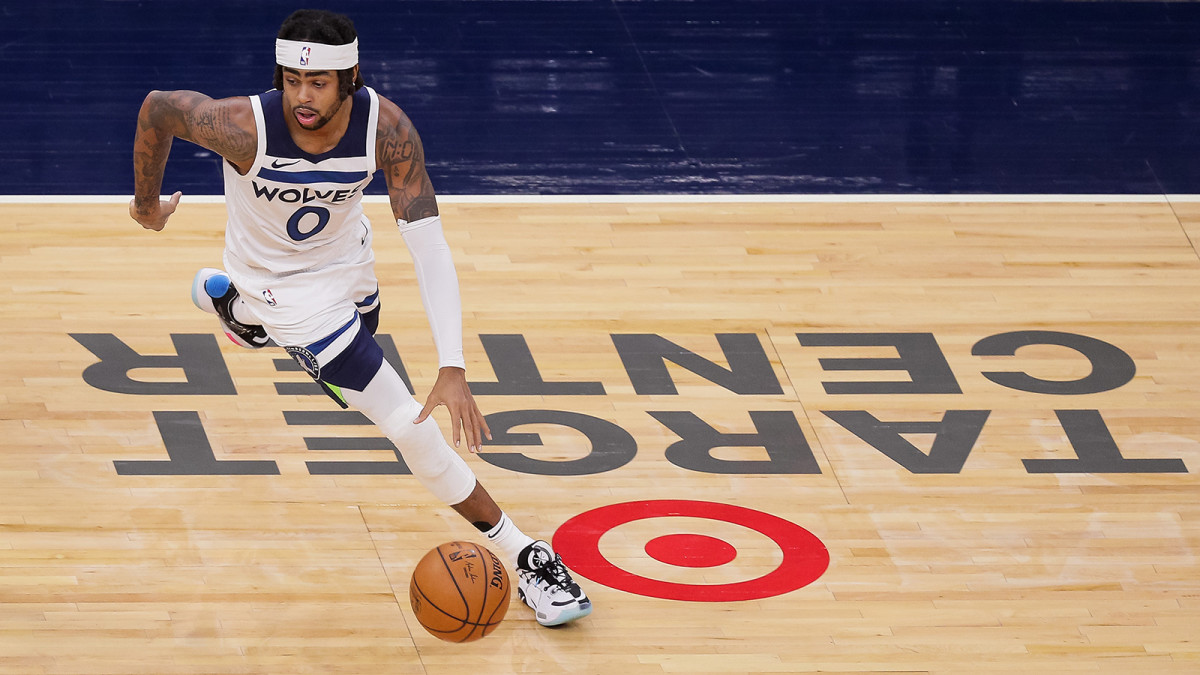
46. D’Angelo Russell, Minnesota Timberwolves
Russell enters the year hoping to lead the Timberwolves to just their second postseason appearance since 2003–04, in what will be his first full season with the franchise. Russell was traded to Minnesota last February and averaged 21.7 points and 6.6 assists per game in 12 games with the team. He has developed into a productive player, capable of playing both on- and off-ball, and he should elevate his close friend and franchise cornerstone Karl-Anthony Towns. Russell will also likely spend a lot of time playing alongside veteran guard Ricky Rubio, whom Russell recently said will take pressure off him in much the same way he did for Devin Booker in Phoenix and Donovan Mitchell in Utah. While Russell has struggled defensively, Minnesota management has made it clear that they view Russell as a centerpiece of the franchise. After months of waiting, Russell said he’s excited for what the season could hold. —B.P.
45. Blake Griffin, Detroit Pistons
We’ll never see Blake Griffin return to his Lob City form after an array of knee injuries, but the modern version of Griffin can still be downright delightful. The former No. 1 pick is an effective point-forward and a quality three-point shooter. His passing instincts (always underrated) are as sharp as ever. It’s a shame Griffin has largely faded from relevance as he toils away in Detroit. Place Griffin on a contender, and perhaps we’d be celebrating his late-career resurgence. Griffin isn’t exactly a knock-down shooter, but he posts solid percentages considering his significant leap in three-point volume. Griffin attempted 322 threes in 2017–18 and 522 the next season, shooting a respectable 35.5% from beyond the arc. Only seven players hit more off-the-dribble threes in 2018–19, and Griffin retained his prowess in transition at 1.22 points per possession. Griffin sees the floor like few players his size. He’s a terrific big-to-big passer in the lane, and his vision out of the pick-and-roll mirrors that of a quality point guard. Let’s hope we see Griffin in the postseason again one way or another, after his disappointing exits with the Clippers. — M.S.
44. Jusuf Nurkić, Portland Trail Blazers
It took more than a year for Nurkić to make his return from a badly broken leg. His triumphant comeback proved one of the summer bubble’s most exciting developments. He showed up having shed weight and picked up where he left off and then some, backing the Blazers all the way to a surprise playoff berth. The best part was how sustainable it all feels. Nurkić’s sublime passing skills and crafty interior game was abetted by a little extra vertical oomph under the basket. His defensive positioning has typically been sound, but he appeared to be moving his feet better than ever. He looked legitimately athletic. With his playmaking and sheer size, Nurkić has fashioned himself into one of the NBA’s best screen-and roll threats, able to command an extra shred of attention while teammates create off him, punish switches, and elevate to the rim when given space. Opponents can ill afford to counter him with smaller bigs, and while he’ll never defend much on an island, he’s harder to play off the floor defensively due to his toughness and commitment. Nurkić was inching closer to his fully realized self even before reshaping his body. He may have unlocked something extra in the process. — J.W.
43. Nikola Vučević, Orlando Magic
Orlando has a serious logjam in the frontcourt, with shoddy guard play and less-than-ideal spacing often limiting its ceiling. Vučević doesn’t seem to mind. As the NBA continues to emphasize stretch and speed, Vučević remains a highly valuable throwback big. He tallied the sixth-most post-up opportunities in the league last season, and only one more player logged more roll attempts. These aren’t criticisms. Vučević is a quality mid-range shooter, and he can finish effectively with either hand. At times, it still feels as though there’s something missing despite Vučević’s impressive point totals. Vučević’s defensive impact is middling. His rebound percentage and free-throw rates fell last year compared to 2018–19. But he’s become more efficient thanks to an increase in three-point attempts, and with different pieces around him, you still wonder whether he might have more to offer. — M.S.
42. Victor Oladipo, Indiana Pacers
After tearing his quadriceps almost two full years ago, Victor Oladipo has yet to consistently display his old explosiveness. As an example, in 2017–18—his last full season—Oladipo attempted 10.8 drives per game, shooting on nearly half of them and converting his attempts at a 52% clip. Last season, despite just a 19-game sample size, he drove to the basket two times fewer per game, and saw his shooting percentage on drives drop to 39.7%. If Indiana is to maintain relevance in the Eastern Conference, he’ll need to re-acclimate himself. New Pacers head coach Nate Bjorkgren told reporters that Oladipo has looked like he has “a lot of bounce to him” this training camp, but it remains unclear whether Oladipo will appear in back-to-back games, something he didn’t do last year in an abridged return. The 28-year-old guard’s future with the franchise also appears to be in doubt, with trade rumors circulating. But a bounce-back would do plenty for his value, and the short-term health of the Pacers. — B.P.
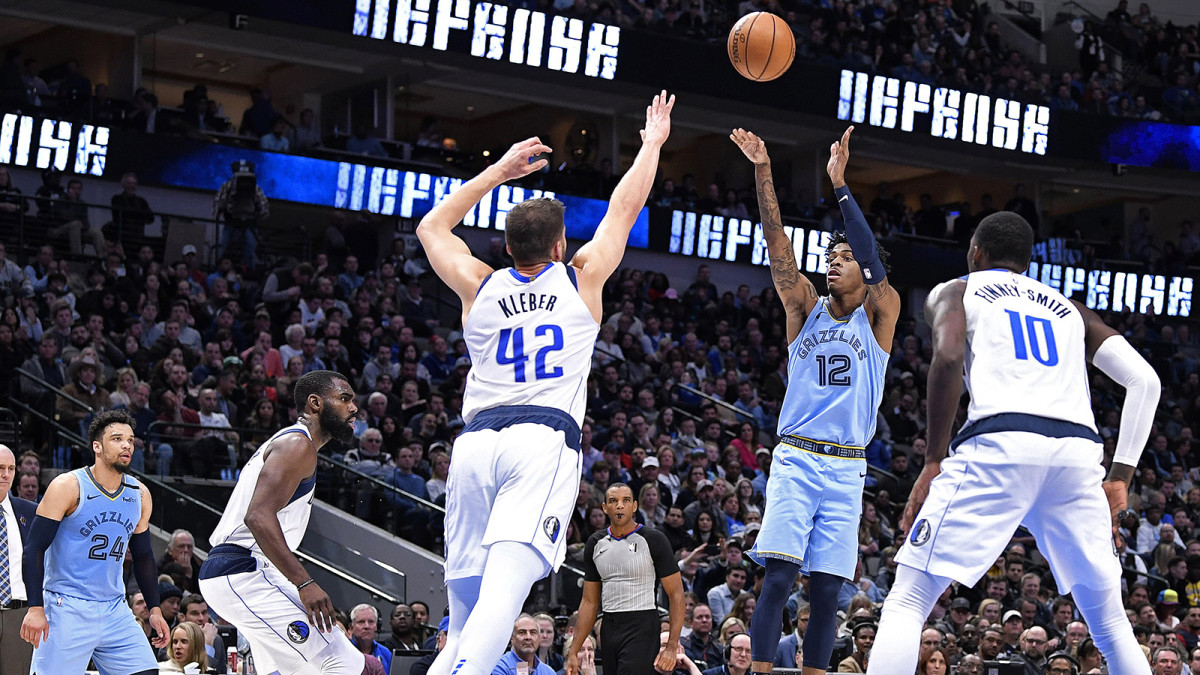
41. Ja Morant, Memphis Grizzlies
How many point guards, let alone 20-year-old rookies, could have led the collection of parts on Memphis’s roster to the cusp of playoff contention? Consider for a second the fact that the tenets of Morant’s explosive style translated directly from the Ohio Valley conference, in transition and the halfcourt, without a fully reliable jump shot. Morant’s Rookie of the Year case was a simple one. He stepped into the NBA and immediately became one of its best playmakers, capable of delivering accurate passes on the move and near-impossible to keep out of the paint. Functionally ambidextrous as a passer and finisher, whenever he gets there, his devastating dunks and craft around the rim threaten equally. Few rookie guards have ever shown up quite so ballsy and unafraid, and while he’s still learning to curb turnovers and defend with intent, it matters that Morant cares less about showmanship and more about making the right play, rarely shooting just to shoot or passing for the sake of it. His brilliance aside, the young Grizzlies were just the league’s 21st-ranked offense last season. As his game evolves, so will the expectations. Still, you shudder at the thought of what might happen if he continues to meet them. — J.W.
40. Kristaps Porzingis, Dallas Mavericks
There are few players in league history quite like Porzingis when he’s healthy. For now, he’s still rehabbing a knee injury that will delay his start to the season. The former Knicks cornerstone is a true unicorn at 7’3”, banging home triples at range. Porzingis tallied 403 three-point attempts in just 57 games last year, and he provided significantly more value from three than his 35.2 % mark would suggest. Porzingis’s ability to stretch well beyond 25 feet creates significant driving lanes for Luka Dončić, and allows the Dončić–Dwight Powell pick-and-roll to thrive. Porzingis is no slouch as a roll man himself. He generates a healthy 1.17 points per roll possession, using his mammoth frame to rise above defenders. It’s understandable that Dallas uses Porzingis as a spacer so consistently. But an added dose of screening action in Porzingis’s diet should help both the talented center and Dallas’s superstar guard. — M.S.
39. DeMar DeRozan, San Antonio Spurs
DeRozan is as steady as he is crafty. The 31-year-old guard enters this season as one of just five players to score 1,500 or more points in each of the last five years. Though the Spurs’ 22-year playoff appearance streak ended last season, DeRozan remained a productive force on the floor, averaging 22.1 points, 5.6 assists and 5.5 rebounds per game while shooting 53.1% from the field. He effectively moonlighted at power forward for a shorthanded team in the bubble, his mid-range skills and craftiness still highly useful. Throughout DeRozan’s first decade in the NBA, he has always been a limited three-point shooter, never making more than three attempts on average per game. In his first season in San Antonio, DeRozan averaged just 0.6 threes per game, converting on just 15.6% of his attempts. While that percentage improved to 25.7% last season, DeRozan will always be a limited commodity from behind the arc, limiting some of his market value, but not his effectiveness. While a move to a contender could be an eventuality, for now, DeRozan returns to San Antonio, providing a stable presence and consistent scoring.— B.P.
38. Jaylen Brown, Boston Celtics
There’s no team in the NBA that couldn’t gainfully employ Jaylen Brown, one of the sharpest players in the league both on and off the floor. Brown, in the absence of Kyrie Irving and with Gordon Hayward in and out of the lineup, put together his best season as a pro in 2020. The 24-year-old averaged career highs in points, assists, rebounds, minutes, free throws, and three-pointers per game. Phew. Brown has always been a heady player, thriving within his means and not trying to take on the mantle of No. 1 scorer. That kind of awareness is incredibly valuable to a roster like Boston’s, with an established All-Star in Kemba Walker and a budding superstar in Jayson Tatum. And that’s not to say Brown, who put up 20.3 points a night, can’t hold his own.
For now, Brown is perfectly cast as Boston’s No. 2b scorer to Kemba Walker’s 2a. (Walker averaged 0.1 points more per game than last season.) Brown is the kind of player who can fill in gaps offensively, shooting well from the outside, breaking out in transition, or create a bucket for himself in mismatches. Defensively, Brown isn‘t Marcus Smart, but he’s more than capable of guarding his position onthe ball, and his athleticism means he can match up against both guards and forwards credibly.
If there’s anything holding him back, it’s that Brown’s offensive repertoire lacks a little bit of flair. This isn’t an insult, but the limits to Brown’s game stand out when compared to a couple of his top-flight teammates. Though he may not have a devastating stepback or consistently collapse the defense, Brown, from the moment he entered the league, has been a significant catalyst for Boston’s consistent success. — R.N
37. De’Aaron Fox, Sacramento Kings
Despite being just 22 years old and having never played in a playoff game, Fox appears well suited as the future of the Kings’ franchise. He signed a five-year extension, reportedly worth at least $163 million, this offseason to solidify his future with the club. Fox saw his scoring increase to 21.1 points per game last year and he shot a career-best 48% from the field. Kings coach Luke Walton appeared almost too comfortable with Fox orchestrating Sacramento’s offense, considering Fox totaled more than 80 touches per game, averaging 5.26 seconds per touch, more than Chris Paul, Kemba Walker or LeBron James. The addition of draft pick Tyrese Haliburton should help reduce Fox’s workload in a positive way. While Fox is a blur in transition, he’ll need to work on his three-point shot to ascend into the top echelon of NBA guards, as he shot just 29.2% per game from deep last year on just 3.6 attempts. He has improved in each of his three NBA seasons, and despite playing in a crowded Western Conference, the Kings are banking on the Kentucky product to lead them to their first postseason appearance since 2006. — B.P
36. Brandon Ingram, New Orleans Pelicans
Brandon Ingram came to New Orleans as the jewel of the Anthony Davis trade, but at the time he was anything but a sure bet. Ingram paired an impressive isolation arsenal with frustrating shot selection in Los Angeles, generating far fewer threes and free throws than are necessary for a player with his skill set. His final season with the Lakers represented a step in the right direction. Year 1 in New Orleans was a revelation. Ingram won Most Improved Player and turned in a relatively dominant offensive season. He scored 23.8 points per game on a markedly improved 39.1% from three, posting the same effective field goal percentage as Luka Dončić. Ingram’s free-throw rate continues to trend upward. His three-point rate has skyrocketed. He receives plenty of isolation opportunities in New Orleans, and while Zion Williamson should earn a greater share of volume in 2020–21, the two franchise cornerstones appear to be complementary cogs. Expect continued growth in Ingram’s second year with the Pelicans. —M.S.
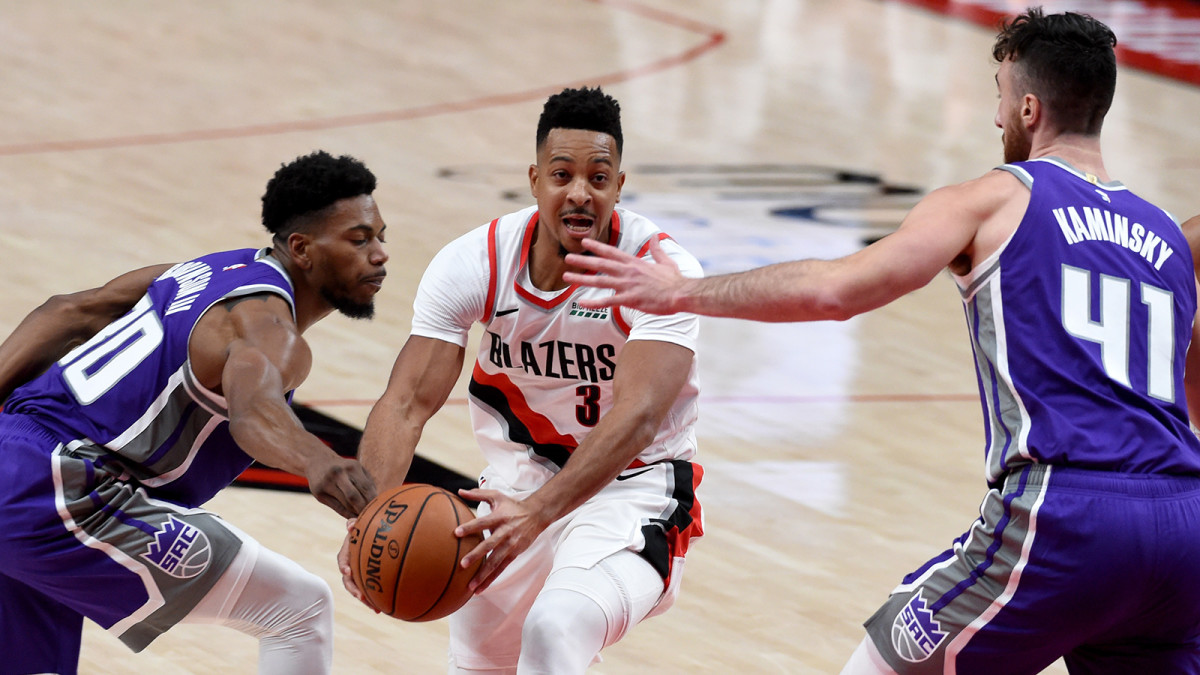
35. CJ McCollum, Portland Trail Blazers
While Damian Lillard provides most of the fireworks in the Blazers’ offense, McCollum remains an indispensable metronome. McCollum’s steady scoring punch is somewhat jarring from a statistical perspective: he’s averaged between 20 and 23 points per game in each of the last five seasons, shooting between 44% and 48% from the field. The statistical profile makes sense, as McCollum’s game isn’t dependent on his athleticism or lift on a given night. He sports a deep array of tricks off the dribble, leaning on shot fakes, spin moves and crossovers to create the necessary separation between himself and a defender. McCollum doesn’t sport the scoring punch of a true leading man, and his 6' 3" frame still creates defensive issues next to Lillard. But Portland’s second banana remains a quality one, having helped drive the Blazers to the playoffs in each of his seven seasons. —M.S.
34. Draymond Green, Golden State Warriors
Draymond Green played in only 43 games last season, averaging the fewest minutes per game of his career since his second season in the league. With the Warriors beset by injuries to the Splash Brothers, a restrained hand with Green made sense. Golden State was going nowhere in 2020 even with Draymond at his best, so trying to preserve his legs for the future was the right call. And speaking of Draymond at his best, placed alongside the right talent, Green is still one of the most well-rounded players in the NBA. He can defend all over the floor. He’s an able and willing playmaker. He can lead a fast break. And his intelligence reeks of years of Finals experience, which means he’s militant about making the right basketball play at every juncture.
The issue for Green is how much longer his body can hold up. The Draymond of the Death Lineup—when he played center and helped unlock probably the best five-man group in NBA history—doesn’t exist in the same way. Green can still reach those heights of tenacious defense and textbook rotations/switches, but doing it night in and night out for every minute he’s on the floor is no longer realistic.
The Warriors as a whole seem to be feeling the effects of their five straight Finals trips. Stephen Curry missed functionally all of last season. Klay Thompson will miss a second straight season after tearing his ACL. Green was never as great as those two players at their height, which means even a little slippage in his game affects him much more significantly. Draymond has always been able to compensate for his shooting struggles, for example, by playing some of the best defense in the league. Ideally, the relative lack of stress of last season and the long layoff will give Green enough of an energy boost to look more like the 2016 vintage as the Warriors try to get back on track. — R.N
33. LaMarcus Aldridge, San Antonio Spurs
There is an ageless quality to the way Aldridge plays basketball. Despite teams’ knowing the core tenets of Aldridge’s game, he is still effective night in and night out. Aldridge has been a stabilizing force in his five years with the Spurs, three of which earned him All-Star appearances. He averaged 18.9 points last year on 49.3% shooting, grabbing 7.4 rebounds per game. And he remains a force in the post, recording the second most post-up touches in the league and shooting 47.3% on his field goal attempts from that area. But despite being largely a known commodity, Aldridge showcased a new skill last year, shooting three three-pointers per game, the most of his career, and finishing the year with a 39.3% mark from behind the arc. Spurs head coach Gregg Popovich recently stressed the importance of Aldridge’s improved three-point shooting, saying that Aldridge has worked throughout the summer and into the fall on his perimeter shooting and “is committed to taking another huge step” in that category. It should help him age gracefully. In a contract year at age 35, Aldridge will look to continue meshing with San Antonio’s young guards and serving as a strong pick-and-roll partner with fellow veteran DeMar Derozan. In a Western Conference rich with talent, Aldridge’s ability to help shape San Antonio’s offense will be an important factor in determining if the Spurs can reach the postseason. —B.P.
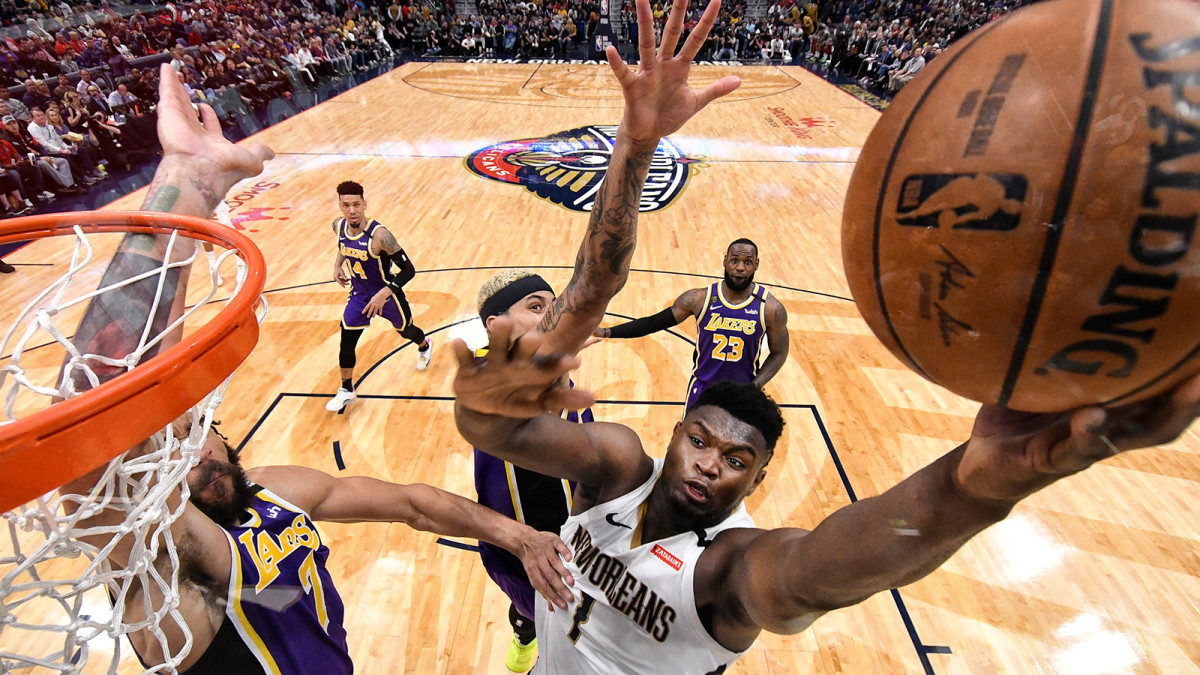
32. Zion Williamson, New Orleans Pelicans
It’s still mind-blowing that Zion Williamson has managed to live up to just about every aspect of his considerable hype: In the 19 games he played before the bubble, he was averaging 35.6 points and 10.2 rebounds per 100 possessions while often being deployed in short spurts, and the Pelicans performed like a top-half, playoff-caliber team on both sides of the floor. Williamson did all this without ever being in peak athletic shape—there’s endless debate over his health and playing weight, but he was inarguably more explosive at Duke. That manifested in a similarly effective, but more ground-bound play style, as well some pronounced defensive struggles as he played conceptual catch-up. Still, speculate all you want about the longevity of his body type, but you cannot argue with the results. When he was active, he was New Orleans’s best player. Williamson is a remarkable finisher around the basket, somehow unfettered by any and all comers, with an astute left hand and a multiple-jump explosiveness under the rim previously unseen in a player his size. He’s a smart passer and decision-maker who’s always been able to maximize his impact without having his number called, allowing him to, in theory, pair comfortably with a second scorer within a winning construct. Provided Williamson can work his way toward a physical peak, the surprising diversity of his game should manifest, and the Pelicans will do everything to showcase it. Instead of worrying what he could become, it’s better to save the clichés and just appreciate what’s already happening. —J.W.
31. Kemba Walker, Boston Celtics
There are moments when Kemba Walker ascends to a plane of unstoppability that are absolutely thrilling to watch. Walker may not have the explosive or flashy quality to his game like some of his point guard contemporaries, and yet he still has periods of sublime scoring that leave defenders helpless. Those stretches when Walker gets going in the high pick-and-roll, pulling up on bigs who dare go under screens or driving by those who get a little too eager, are very satisfying to watch. Even with Jayson Tatum earning plaudits as Boston’s lead dog, there are moments when Walker looks like the best scorer on the team.
Kemba has found a good home in Boston, where he doesn’t have the burden of being the No. 1 but can command the offense when necessary. He’s a high-volume, high-efficiency three-point shooter, and the stepback, midrange J is still as pretty as it was at Connecticut nearly 10 years ago. Of course, there are concerns. Walker experienced knee issues last season that will also cause him to miss the start of this one. His size makes him a frequent target on defense, and calls into question how effective he can really be in an ultra high-stakes playoff game. Knee, size, and defense problems are usually not kind to 30-year-old point guards, especially ones on max contracts.
But those moments, people. When he does return to play, Walker is going to have one, two, three, however many of those nights when the ball can’t help to go in, like when he dropped 40 on the No. 1 Bucks last season, or 44 on the Pacers. Walker’s game isn’t as memeable as pull-ups from halfcourt. Don’t let that stop you from enjoying someone who is still a masterful bucket getter. — R.N
Nos. 30-11
30. Pascal Siakam, Toronto Raptors
The honeymoon wasn’t quite as sweet for Siakam, who hit a wall without Kawhi Leonard during Toronto’s seven-game Eastern Conference semifinals loss against the Celtics. Siakam, who made his first All-Star team last February, averaged fewer than 15 points on less than 40% shooting and often looked overmatched as the Raptors’ lead playmaker. Still, over a larger sample size during the regular season, Siakam displayed significant improvement and did appear to be a potential franchise star. His scoring jumped from 16.9 points to 22.9 points per game in the regular season, and he made improvements in his three-point shooting. “I had to shoot [threes] in the NBA and I didn’t have to shoot them in college,” Siakam told Sports Illustrated’s Chris Mannix last fall. “I think that’s a big difference.” Siakam will continue working on his outside shot as he looks to develop a more well-rounded game. He is a versatile defender and pairs nicely with OG Anunoby on the wing. Now in his second season in more of a leadership role with the Raptors, Siakam will look to keep building on his upward trajectory. —B.P.
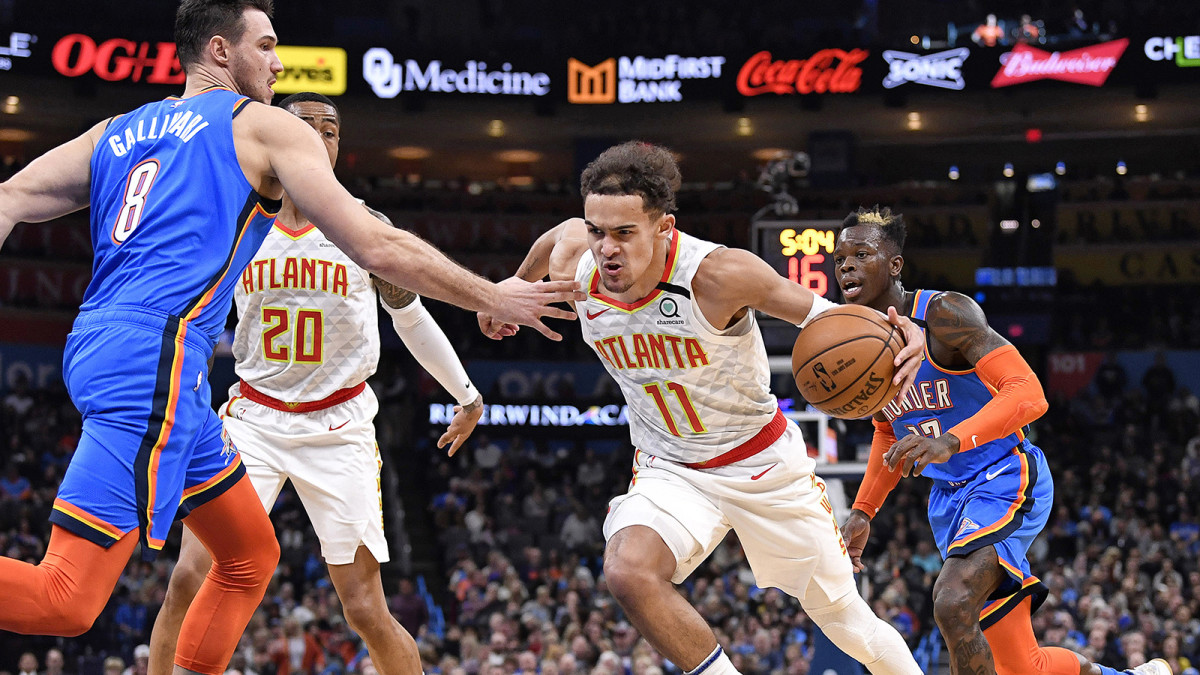
29. Trae Young, Atlanta Hawks
Young flashed his prodigious scoring talent as a rookie, but he often looked overmatched amid a concerning amount of turnovers and a shaky shooting percentage. Year 2 was far more encouraging. Atlanta’s point guard finished fourth in scoring at 29.6 points per game in 2019–20, and perhaps more importantly, he turned in a far more efficient season. Young rose from 32% to 36.1% from three even with a leap in attempts, and he improved his effective field goal percentage by a marked margin. Young’s vision is truly elite in the half-court. He’s evolving as a pick-and-roll ballhandler. And even in a shaky situation, Young still managed to turn in an elite offensive season for a player of his age.
Young’s 30-foot bombs create an obvious comparison to Steph Curry, but the conflation can be a little misplaced. Curry is one of the best off-ball shooters of all-time, wreaking havoc on defenses as he darts around screens and resets his position after a pass. Young’s approach, at this stage of his career, is more statuesque. He attempted just 105 spot-up threes last season, the same amount as Frank Ntilikina and (interestingly) James Harden. Young doesn’t make any marked impact without the ball in his hands. He turns the ball over at a higher rate than Curry ever did, and while Steph isn’t earning All-Defense honors anytime soon, Young remains a sieve by comparison.
Despite his flaws, Young is a legitimately thrilling offensive talent, and he’ll inherit the best roster he’s had yet. Further refinement from Young on both ends of the ball in his third year could launch him into the league’s elite. Right now, despite his gaudy stats, he’s still outside All-NBA consideration. —M.S.
28. Kyle Lowry, Toronto Raptors
In the immediate aftermath of Kawhi Leonard’s departure, there were questions about what direction the Raptors would take. Would Masai Ujiri start tearing down the team and trade away his veterans? Instead, Ujiri put all speculation to rest when he signed franchise icon Kyle Lowry to a one-year extension last October. With the understanding Toronto planned to vigorously defend its title, Lowry had a remarkable 2020. The 34-year-old averaged 19.4 points per game last season, the second-best mark on the club and his most since 2017. Even at his advanced age and with years of playoff runs on his body, Lowry remains one of the most impactful guards in the game.
He does everything you want. Pull-up and spot-up threes. An ability to draw fouls. (Fun fact: Lowry’s free-throw rate last season was the fourth-best of his career and highest since 2009.) Aggressive defense. But most of all, while his critics and opponents may find him to be a nuisance, Lowry is one of the most intelligent players in the game. He can seemingly leverage any situation to his benefit. Often that means trying to find a foul at any cost, but there’s also no question Lowry is willing to put his body on the line in a way few people of his age and size are willing to do on such a consistent basis. Toronto was a legitimate contender last year, and Lowry, with his wit, guile, and skill, was the biggest reason why.
At 34, it is fair to wonder how much longer Lowry can keep this up. His style of play takes a physical toll. But with the emergence of Pascal Siakam and Fred VanVleet, the Raptors are hoping to lighten his burden. If this season does end up signaling a shift in Toronto, any team that takes itself seriously would welcome Lowry with open arms. — R.N
27. Khris Middleton, Milwaukee Bucks
While Giannis Antetokounmpo has been at the center of the Bucks’ success in recent years, Khris Middleton has been an integral part of the franchise’s rise unto himself. He’s made the All-Star team in each of the past two years and has shown gradual improvement throughout his career, leading up to career highs in points (20.9), rebounds (6.2) and field goal percentage (49.7) per game last season. The former second-round pick also provides the Bucks with flexibility on the defensive end and is versatile enough to guard at least three positions. While a number of Bucks have put up underwhelming playoff numbers in recent years, Middleton has also been a consistent postseason performer, even upping his scoring average by three points per game in 2019–20. The addition of Jrue Holiday should also provide even more flexibility, as the Bucks’ newly formed star trio looks to lead the franchise to its first title since 1970–71. —B.P
26. Jrue Holiday, Milwaukee Bucks
Quantifying a player’s true worth defensively can be challenging, but the near-unanimous respect Jrue Holiday has earned from opponents going on the better part of a decade speaks for itself. His unique ability to make opponents uncomfortable, working them quietly off their line to the rim, taking away personal space without fouling, and bending but rarely breaking, has become something of a lost art. Holiday defends guards, wings and even bigs without flinching, his combination of strength and quickness at 6’4” proving unusually functional over the years. He stops the ball, he plays the passing lanes, he’ll switch onto anyone and he understands better than any guard in the league how to leverage his size against taller players. As Holiday’s final season with the Pelicans often demonstrated, no player alone can make a defense great. But the massive haul of future draft picks the Bucks surrendered for him had as much to do with Holiday’s lofty status as it did Milwaukee’s urgency.
While Holiday is not a point guard by nature, he can moonlight on the ball effectively and grab and go off the defensive glass. He’s not an elite jump shooter, but he commands respect on the catch. Few players have the energy or wherewithal to provide elite defense as a constant, and accentuating it with a viable, high-usage role on the other end. Holiday still finds time to stuff the stat sheet. It’s hard to put a price on the type of creative optionality a player like that can afford his coach. His shooting percentages ticked down after the Pelicans traded Anthony Davis and should benefit in much the same way when flanking Giannis Antetokounmpo. Holiday remains as well-rounded a secondary star as you’ll find anywhere in the league, and time and again, he proves it. —J.W.
25. Russell Westbrook, Washington Wizards
So what should we make of Westbrook after 12 seasons, nine All-Star teams, one MVP and (roughly) a million hot takes? Will we see the Westbrook of the NBA bubble, where he limped through the postseason as his Houston tenure ended in disaster? Or will Westbrook quickly return to form with his third franchise, reminding us all just how physically dominant he can be? There’s reason to bet on the latter. Westbrook was downright dominant for a significant stretch in 2019–20. He averaged 32.9 points, 8.3 rebounds and 7.1 assists per game in his final 20 contests before the season’s hiatus, carrying Houston’s offense as James Harden struggled through an extended shooting slump. Westbrook remains a lethal force at the rim and in transition. He’s an impactful cutter when he wants to be, and he quietly turned in the most efficient season of his career in 2019–20. Vintage Westbrook was arguably the best athlete in NBA history. The current version is still close to the top of the league.
Still, the flaws are more obvious than ever with Westbrook. His jump shot oscillates between middling and broken depending on the week, and his stubbornness regarding said jumper can create plenty of frustration. Acquiring Westbrook means you get the whole package. He’ll bring his maniacal work ethic and competitiveness to each stop. A culture of accountability will be established. But with those benefits comes a certain cost. Houston nearly blew its first-round series against Oklahoma City as Westbrook domineered the action. A strong stretch in 2020–21 could carry the Wizards to the postseason. But in a given series, Westbrook’s shortcomings can sink his team. —M.S.
24. Devin Booker, Phoenix Suns
The Phoenix Suns dug themselves a sizable hole before the league stopped play in mid-March and so, despite an 8–0 seeding game run in the NBA bubble, the Suns missed the playoffs for the 10th consecutive season. But Booker nearly willed his way to the postseason, averaging 30.5 points per game on 50.3% shooting in Orlando. A proven bucket getter, Booker averaged 26.6 points per game for the second straight year, leading the Suns in scoring yet again. While Booker is always a threat from the perimeter, his numbers from deep are also statistically underwhelming, at least by his standards, with him shooting just 35.4% from three, though the difficulty of his attempts has something to do with it. Phoenix’s trade for All-Star guard Chris Paul will surely help Booker find more space on offense. Still just 24 years old, Booker will look to continue his ascension into the league’s upper echelon of guards this season, as the franchise eyes a playoff berth. —B.P.
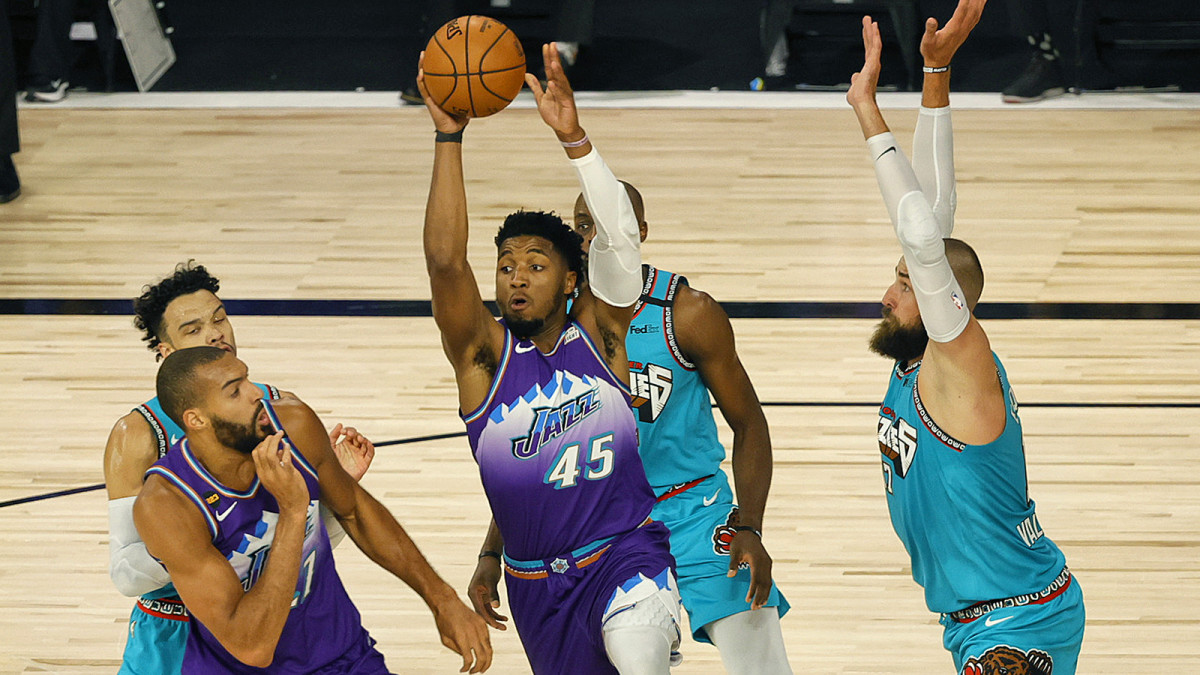
23. Donovan Mitchell, Utah Jazz
The game continues to slow down ever so slightly for Mitchell, who is refining his naturally helter-skelter approach to scoring and coming off the best season of his young career, managing a 55.8% true shooting clip on 30.8% usage, making his first All-Star team and taking a major step toward All-NBA status. Mitchell announced himself in full over the course of an epic series against the Nuggets, trading blows with Jamal Murray, dropping two 50-point games, and pushing Denver to seven games, over the course of which he converted 53% of his twos, 51% of his threes, 94% of his free throws and averaged 36 points. He’s a challenge to keep out of the paint and gets separation for himself on the perimeter, and he does all that while still playing defense, standing 6' 1" and never seeming to relent.
Of course, Mitchell may never match that impossible hot streak again. But he’s ascended the ranks of the league’s most potent scorers for a reason, and there’s plenty more for him to accomplish. If he settles for fewer floaters and uses his explosiveness to put more pressure on the basket, he’ll surely get to the free throw line more than four or five times per game. Mitchell draws plenty of defensive attention and can become a better creator for his teammates during his frequent forays into traffic. Becoming less ball-dominant might lead to more catch-and-shoot looks and another uptick in his percentages. He’s only 24, and it’s all on the table. But Mitchell doesn’t have to do any of those things to be one of the toughest nightly covers in the league. And that’s the scary part. —J.W.
22. Jamal Murray, Denver Nuggets
Clearly enough, the Nuggets’ magical postseason run—which saw the franchise overcome two 3–1 series deficits—would not have happened without Murray’s stellar play. While many of Murray’s regular-season averages were nearly identical in 2018–19 and 2019–20, the Canadian guard’s scoring jumped eight points per contest in last year’s postseason. He scored 30 or more points in six of Denver’s 19 playoff games, putting up multiple 40- and 50-point showings, and also averaged nearly two more assists per contest. When the 23-year-old Murray agreed to a five-year, $170 million extension in the summer of 2019, some questioned Denver’s decision to anoint Murray as a franchise centerpiece despite his having never made an All-Star team. Now, such doubts appear moot, as Murray enters the 2020–21 campaign poised to build on his stellar playoff run. Alongside two-time All-Star Nikola Jokić and a series of promising role players, it seems as if Murray and the Nuggets will only continue to rise. “We have two superstars in Nikola and Jamal,” head coach Mike Malone said this past September. “And a lot of other really good, young talented players behind them.” —B.P.
21. Ben Simmons, Philadelphia 76ers
Sneer at Simmons’s three-point phobia if you wish, but Philadelphia’s point guard remains one of the game’s most electric guards. Simmons is an absolute force in transition, bullying his way to the rim with a combination of size and speed unmatched throughout the league. The LSU product thrives off of turnovers, and he increasingly leans on his athletic gifts to generate free points for Philadelphia. Simmons won the steals title last season en route to his first All-Defense selection. He paired his ball-hawking skills with improved rotational awareness, anchoring Philadelphia’s defense. For all his half-court shortcomings, Simmons’s transition prowess and defensive dominance makes him one of the Eastern Conference’s most valuable players.
Simmons sports the athletic profile to be a top-10 player. But the flaws in his game grow increasingly frustrating by the season. It’s not just that Simmons is a poor shooter. It’s that he’s an unwilling one. Philadelphia’s point guard attempted just seven threes in 2019–20. He attempted 16 midrange jumpers. Perhaps Simmons’s stylistic deficiencies would be acceptable if he were flanked by a cadre of shooters, but given his big-man costar, the lack of any discernible jumper can be downright untenable. Even extending his range past the free-throw line would do wonders for Philadelphia, further unlocking the two-man game between Simmons and Embiid. Perhaps Simmons will show some growth in 2020-21. If not, he’ll remain a tantalizing, yet frustrating talent on the fringe of the All-NBA discussion. —M.S.
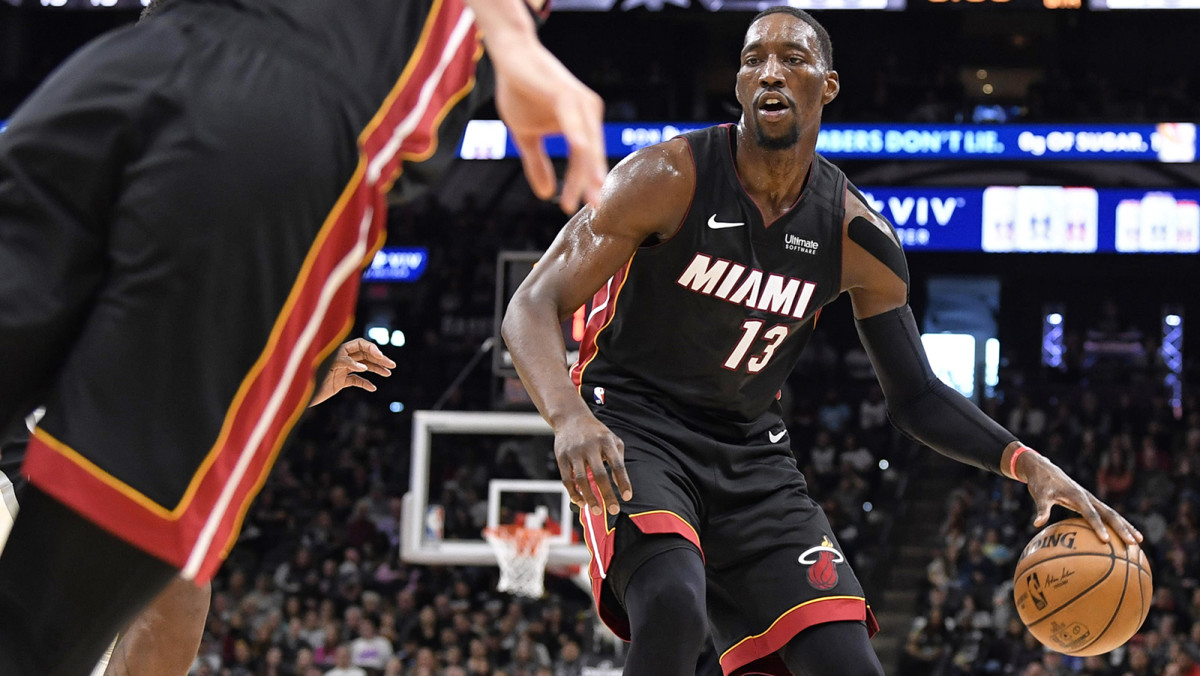
20. Bam Adebayo, Miami Heat
Seemingly once a game, an opposing perimeter player will make the mistake of thinking they have a mismatch against Bam Adebayo. Catching Adebayo in a switch, said perimeter player often calls for an isolation and then tries to blow by Bam to the rim. And sure enough, once a game, that player learns they’ve made a terrible mistake as they quickly realize they have nowhere to go.
Adebayo is one of the most well-rounded players in the NBA, and he’s the crown jewel of the Heat’s future. Jimmy Butler often refers to him as the team’s best player, and that refrain may be more than just modesty.
Bam’s footwork and intelligence belie his age. At 23, he should already be a consistent candidate for Defensive Player of the Year. He can truly guard any position on the floor, banging with beefy centers or staying in front of speedy guards. His block on Jayson Tatum at the end of Game 1 of the 2020 Eastern Conference Finals was not only picture perfect, it told the story of how special Adebayo is. He wasn’t guarding Tatum on that play—but Adebayo timed his release from his own man to be in perfect help position on Tatum, he had the athleticism to meet him at the rim, and then the awareness to keep the ball in bounds and in Miami’s possession.
On the other end of the floor, Adebayo is a fulcrum in the Heat’s motion attack. He’s a deft passer, and Erik Spoelstra often relies on him in lieu of a playmaking point guard to direct the offense. Bam is deadly on handoffs, and his jumper is steadily improving. After mostly being a rim runner his first two seasons in the league, Adebayo morphed into an elbow traffic cop in 2020, ultimately averaging 15.9 ponts, 10.2 rebounds, and 5.1 assists per game. And he has the potential to be so much more. Just ask the Celtics again, who saw their season ended by Adebayo’s 32 points in Game 6 of the East Finals, including when he went on a run by himself in the fourth quarter, stunning Boston with a flurry of offensive moves to send them packing. Bam is No. 20 on this list, but he’s really just getting started. — R.N
19. Kyrie Irving, Brooklyn Nets
There always seems to be some form of discontent surrounding Kyrie Irving, who holds the crown as the NBA’s most mercurial superstar. Irving’s tenure in Cleveland ended with a trade demand. He exited Boston after a tumultuous two seasons, and his first year with Brooklyn featured its own share of controversy. But perhaps we’re focusing too much on questions surrounding Irving’s peculiar personality. Brooklyn’s point guard remains one of the game’s top scorers, and, paired with Kevin Durant, it’s possible we’ll see him hoisting the Larry O’Brien Trophy in 2021. Harp on the backpage headlines if you’d like. Doing so ignores Irving’s immense talent. There are few guards in league history as purely gifted as the 2016 champion.
Irving’s sheer statistical resume in recent seasons shouldn’t go unnoticed. He’s one of two players (along with Steph Curry) to average more than 24 points per game while shooting over 40% from three in the last four seasons, and 2019–20 featured Irving’s most impressive offensive campaign. The Duke product averaged 27.4 points per game with a 54.6 effective field goal percentage, scoring 1.06 points per isolation possession. Irving is perhaps the most malleable offensive point guard in today’s game. He’s a dominant force with the ball in his hands, sporting the league’s deepest bag of tricks off the dribble. Irving is also a dangerous off-ball spacer, likely making him a perfect complement to Durant in 2020–21. Irving’s defensive shortcomings are notable. He’s not the warmest personality by most accounts. Yet there’s no denying his historic talent. Don’t be surprised if we see Irving dicing up defenses late into the 2020–21 postseason. —M.S.
18. Karl-Anthony Towns, Minnesota Timberwolves
There isn’t much that the Timberwolves star can’t do, especially on the offensive end of the floor. Towns averaged a career-high 26.5 points last season, while shooting 50.8% from the field. He was an impact player in the post and a top player at any position from beyond the arc, shooting 42.5% from behind the arc on his 5.9 catch-and-shoot three-point attempts per contest. But on the defensive side of the floor, the Wolves struggled last season, finishing as a bottom-third unit, with Towns playing in just 35 games. His own defensive concerns remain as pronounced as ever. Towns will look to mesh with D’Angelo Russell, who is beginning his first full season with the franchise, and top pick Anthony Edwards. The Wolves have surrounded Towns with a number of talented pieces, and the hope is that this season will offer a better gauge of where the franchise stands. — B.P.
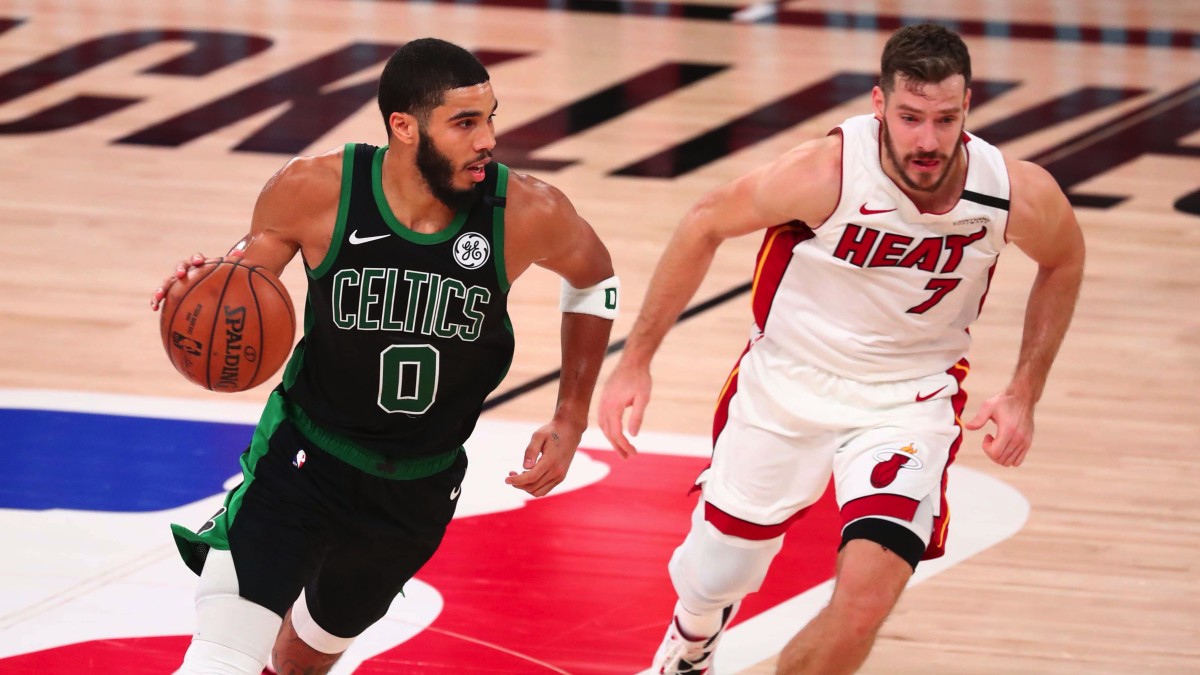
17. Jayson Tatum, Boston Celtics
No one in the NBA made as significant a leap as Jayson Tatum did in 2020, when he went from promising young gun to “Oh my god, this kid is about to be a superstar.” The 22-year-old was sublime for the Celtics last season, leading the team in scoring despite sharing the ball with vets like Kemba Walker and Gordon Hayward. Tatum was bonkers, averaging 23.4 points, 3.0 assists and 7.0 rebounds per game. He shot a comical 40.3% from three on 7.1 attempts a night, turning his stepback jumper into one of the most lethal shots in the Association.
Tatum has the talent to be a scoring leader one day. He can get a bucket from the outside, from the midrange, or by making his way to the rim for a finish or foul. Few guys this early in their career are supposed to have such a layered offensive game, but Tatum plays with the smoothness of a 10-year-vet. His three-point shooting was particularly notable after complaints about him settling for too many long twos in 2019. Tatum bumped up his efficiency last season, and what’s frightening for opponents is how he should only improve from here. Defensively, Tatum isn’t a lockdown guy, but he doesn’t cheat on that end of the floor, and he’s a key part of Boston’s elite unit.
Tatum is dripping with polish and yet he’s so far away from his prime. He has many offseasons to tinker with his game. Maybe he wants to add more to his post catalogue. Or maybe he wants to perfect a baseline turnaround. With so many skills already in his arsenal, Tatum is building on a foundation much more advanced than a typical third-year player. And he has the prototypical size—6’ 8”, 210 pounds—to become one of the league’s dominant wings.
The Tatum era in Boston is quite young, but he’s already been a key contributor on two trips to the conference finals in only three seasons. It would almost be shocking if Tatum didn’t bring Boston back to the Finals sooner rather than later. — R.N
16. Rudy Gobert, Utah Jazz
Employing the NBA’s top defensive center affords a certain degree of stylistic comfort: Over Gobert’s six seasons as a full-time fixture in Utah’s lineup, the Jazz have finished first, second, first, second, fourth and ninth in points allowed per game, often employing a plodding pace and making the playoffs in five of those years. Utah’s performance in the postseason has been a different story—draw the wrong opponent, and the 7' 1" Gobert can look out of his depth rather quickly—but we’re talking about a two-time Defensive Player of the Year who’s made first-team All-Defense in four straight seasons. Indisputably, Gobert remains the best rim defender in basketball, he rebounds at an elite clip on both ends, he’s proved relatively durable for someone his size and he’s a puzzle opponents are forced to solve every night.
Like an expert center back or rangy middle linebacker, Gobert forces an offense to simply maneuver its way around him, or avoid him entirely. It’s not so much as the shots he blocks anymore as the angles he takes away, and he’s disciplined, averaging just 3.3 fouls per 36 minutes. As with any 7-footer, some physical decline is eventually in the cards, but at age 28, Gobert remains a tad more mobile than you think, his length proving a great equalizer in changing angles and effecting shots when he’s forced to defend in space. Remember that when the Jazz have gone down in the playoffs, it’s been at the hands of elite offensive talents: James Harden, Stephen Curry and, last year, an ascendant Jamal Murray. They’re guards who can expertly manipulate ball-screen coverages and need just a sliver of space to launch deadeye threes. Lest we forget, most teams don’t have a player like that and have to simply deal with the massive, intelligent man walling off the paint as best they can. As Gobert enters a contract year, Utah will lean on him as long as it’s feasible. —J.W.
15. Bradley Beal, Washington Wizards
In Year 8 of a still-underappreciated career, Beal stretched his game to its limits and walked away with another notch in his belt, averaging a career-high 30.6 points without sacrificing much in the way of efficiency. And he did so as the primary focus of nearly every defense he faced. He shot worse from the field on the whole with the added workload, but made it to the foul line more often and averaged a career-high in assists as the top playmaker in a transition year. He’s been perhaps the NBA’s most durable star, racking up minutes without complaint. He took a real leap in the absence of John Wall, and now the Wizards are betting on Beal’s unusual malleability as a viable fit with Russell Westbrook. He remains an elite catch-and-shoot player and could easily inch close to his old neighborhood of 40% from distance if all goes well. There simply aren’t many holes in Beal’s offensive game, with equal capacity on and off the ball, off the catch or using a screen.
As the Wizards continue to bat away trade offers and build around Beal, the prospect of his game continuing to improve points to why Washington would hold. Having Westbrook around, you’d hope, will reduce Beal’s creation duties, allow him cleaner looks as a play finisher and improve his results all over the floor. If he takes all he’s learned and demonstrated over the past two years, acquiesces a tad to his new teammate and stays just as effective, Beal could conceivably repeat his 30-point campaign with less exertion, and perhaps more wins for his team. There are players on this list who are more prolific, but few as consistent and reliable. —J.W.
14. Chris Paul, Phoenix Suns
Everywhere Chris Paul goes, winning follows. In case that wasn’t obvious, the 2020 Thunder are a shining example. After reviving the Clippers and nearly bringing the Rockets to the Finals, CP was unceremoniously shipped to Oklahoma City in the summer of 2019. Instead of trying to force his way out to a contender, Paul, who turned 35 in May, went to work and put together one of the finest individual seasons of his career. CP averaged 17.6 points, 5.0 assists, and 6.7 rebounds per game for the Thunder, while shooting 48.9% from the field. The only other players in the league to average that many points, assists, and rebounds per game while shooting at least 48% from the field last season were LeBron James and Nikola Jokic. That’s how incredible Paul was, all while being a clutch-time assassin for a team that was a Lu Dort three away from upsetting the Rockets in the first round of the playoffs.
Paul looked rejuvenated in OKC. Not only did he relish the role of playing point guard again, he told SI in December 2019 his body felt transformed after changing his diet and workout regimen after the trade from Houston. Paul now only eats plant-based meals, and hired a new trainer after injuries zapped some of his effectiveness as James Harden’s running mate. If those lifestyle changes are long lasting, then the Suns should be a legitimate force this season. So much of the conversation around Paul is about his large contract—and how he will definitely not opt out of the last year of his deal to give himself more flexibility. Well, CP was worth every penny in 2020. Count out the Point God at your own risk. — R.N
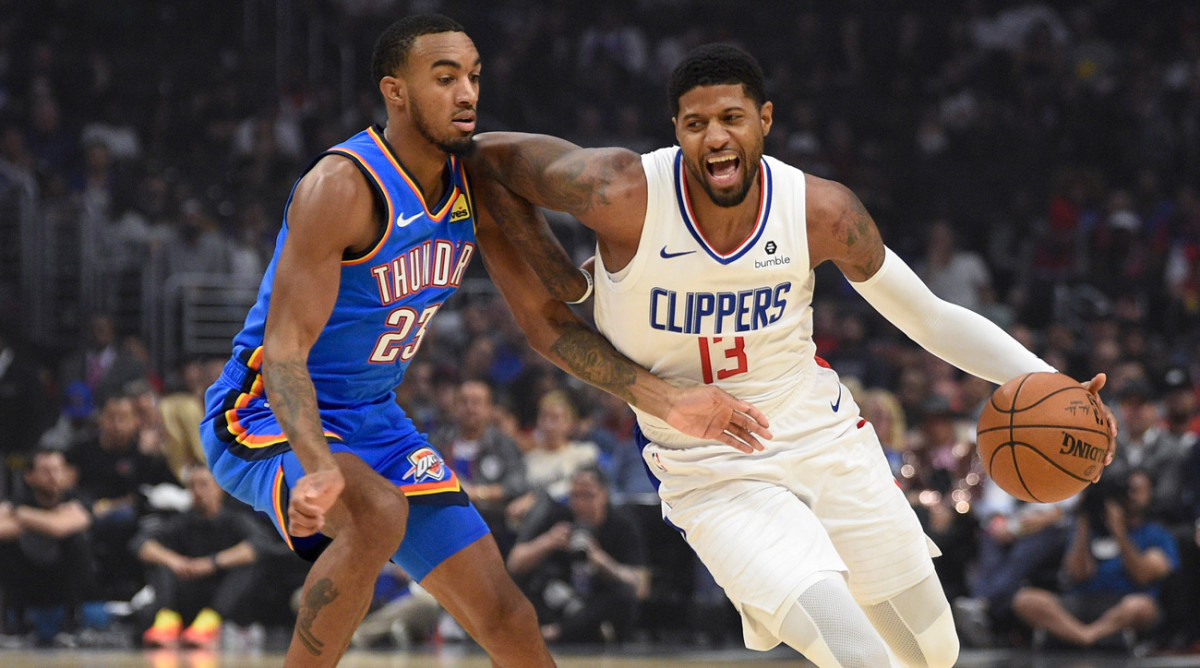
13. Paul George, Los Angeles Clippers
It’s become almost impossible to separate the short-term playoff conversation around Paul George from who he really is as a player. Did George struggle during the Clippers inexcusable seven-game loss in the bubble to the Nuggets? Yes. Was the front office smart to sign him to an extension this summer? Absolutely.
PG is far from a scrub. Let’s put that to bed right now. He was an MVP candidate in 2019 before hurting his shoulder. And he was carrying that Thunder team that also included Russell Westbrook. George remains an All-NBA caliber defender with an offensive game that’s expertly suited for the modern game. Once healthy, George was exactly what the Clippers needed last season. A deadly second option who could create for himself when called upon while being an absolute sniper from three. PG looked completely recovered from his shoulder troubles with the Clips, shooting a career-high 41.2% from beyond the arc. If anything, L.A. was too cautious with George, playing him only 29.6 minutes a night in the regular season, his fewest since his rookie year (excluding the 2015 season when he played in only six games off the bench after breaking his leg.)
While George may fall short of being the true No.1 on a championship contender, it would be asinine to cast him aside as some kind of punchline. He has a recent history of some postseason foibles. He also once impressed LeBron so much that James dapped him in the middle of a playoff game between two heated rivals. At 30 years old, George isn’t an up-and-comer, but he still has time to rewrite the book on the kind of player he is in high-stakes moments. For someone with so much talent, the story is far from over. — R.N
12. Damian Lillard, Portland Trail Blazers
Perhaps to nobody’s shock, Lillard was the league’s most prolific player in the run-up to last year’s postseason. With a number of eye-catching performances, Lillard led Portland from outside the Western Conference’s playoff picture to the No. 8 seed, a run required after injuries plagued the Blazers throughout the regular season. Overall, Lillard averaged career highs in points (30) and assists (8) per game, while shooting 40.1% from three. He is also currently the league’s best long-range three-point shooter, taking 6.8 attempts from 25 to 29 feet last year and shooting 40% on them. Throughout the offseason, Portland made a number of key acquisitions, bringing in versatile forwards Robert Covington and Derrick Jones Jr., and center Enes Kanter. The team also re-signed forwards Carmelo Anthony and Rodney Hood. Lillard recently said that his message to team president Neil Olshey was: “Let’s go for it.” The Blazers are just one full season removed from making the Western Conference finals, and it appears as if another berth in the league’s final four is fully possible, especially if Lillard shows even more improvement this season. —B.P.
11. Jimmy Butler, Miami Heat
The most interesting man in the NBA, Jimmy Butler found the perfect home for himself in Miami, where the Heat welcomed his aggressive playing style en route to a shocking Finals berth. In the process, Butler outplayed two-time MVP Giannis Antetokounmpo in the second round of the postseason, and then with his two best teammates (Adebayo and Dragic) injured, he frankly single-handedly took two games off the Lakers in the championship round.
Though he had some big nights in the playoffs—including his iconic 40-point triple double in Game 3 of the Finals—Butler wasn’t asked to be a traditional scorer for Miami in 2020. He averaged a modest-for-a-perimeter-star 19.9 points a game during the regular season, but he compensated by adding 6.0 assists and 6.7 rebounds a night, both career-bests. Butler showed a knack for controlling the game when the Heat needed him to the most. With a shaky jump shot, he turned in a Harden-esque 9.1 free-throw attempts a game, willing himself to the line whenever his team needed a bucket throughout the season. For all his past escapades, Butler was measured his first season in Miami, picking his spots offensively while playing his typical stellar defense on whoever was in front of him. (And for what it’s worth, the only other players with at least a 19.5-6.5-6.0 statline with better than 45% shooting were Luka, LeBron, Russ, and Jokic.)
What Butler proved during the Heat’s surprise run through the East is that he can be the No. 1 player on a championship contender. Few players—even some above Butler on this list—can confidently make that claim. If there are any concerns, it’s that at 31-years-old, Butler is no spring chicken. His jump shot is a valid issue. And for all the leadership he brings, he’s not going to put up the numbers of an MVP candidate.
Still, when the stakes were at their absolute highest, Butler delivered. And he did so with aplomb, flashing playmaking, defense, rebounding, and of course scoring in the Finals, giving LeBron a legitimate run for his money. Some people are already calling Miami’s playoff run a fluke. As for Butler? He told SI he has something up his sleeve for next season. And only it’s getting harder to doubt Butler’s will.
Nos. 10-1
10. Joel Embiid, Philadelphia 76ers
Few bigs, if any, are currently as dominant as the 76ers center. Embiid bullies smaller defenders and is too skilled for those who might be a closer physical comparison. Around the rim, he is a foul-drawing machine and additionally led the league in post-up points with 7.4 per game. Embiid also provides the Sixers with a consistent bail-out option, having taken the most field goal attempts per game with between zero and four seconds on the shot clock last season, making 41.5% of them. While Embiid saw a number of his counting stats decrease this past season, he’s poised for an uptick alongside a revised core that now features a number of sharpshooters, with the Sixers’ notably adding Danny Green and Seth Curry in trades this offseason, hoping to free up more space for Embiid around the basket. While durability remains a concern for the 26-year-old center, Embiid could very well be the best big in basketball. Don’t be surprised if he leads the Sixers toward a top-four finish in the Eastern Conference and a deep postseason run. —B.P.
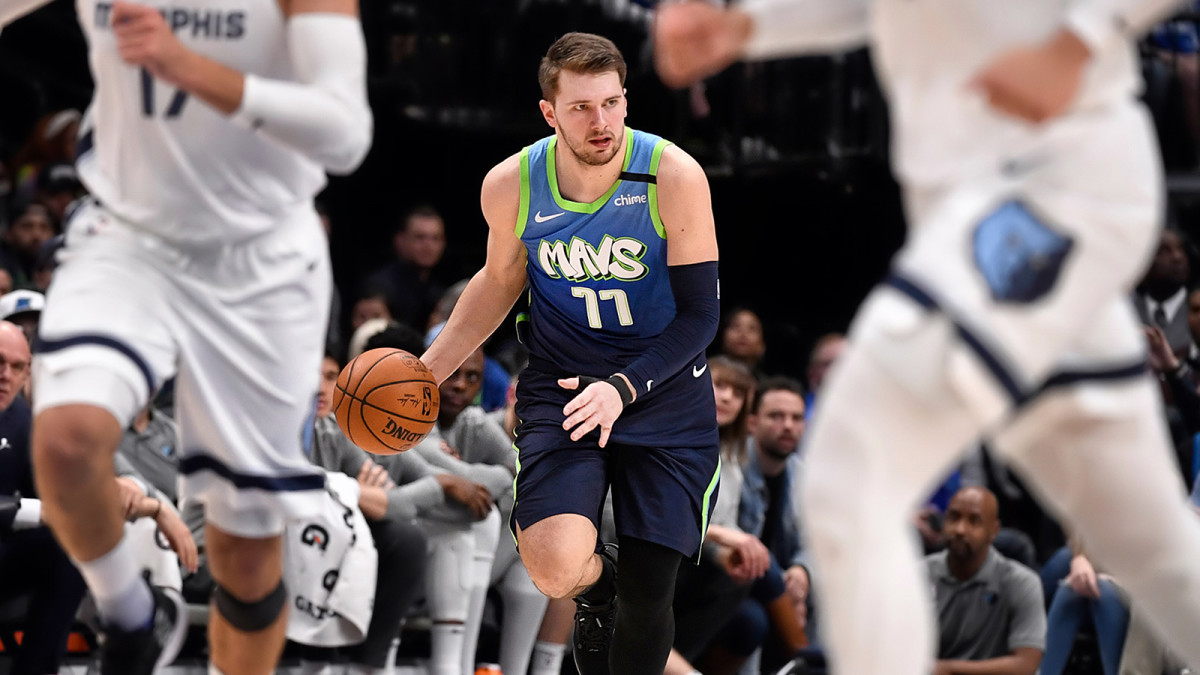
9. Luka Dončić, Dallas Mavericks
There’s an abundance of ways to contextualize the incredible things Luka Dončić has accomplished by age 21. Suffice it to say, there’s a high likelihood what we’re witnessing is the emergence of the NBA’s next true alpha talent, and a player who could conceivably be in contention for the No. 1 spot on this list a year from now. He lands ninth on our list out of respect to the players ahead of him, but Dončić is closing in quickly, and, truthfully, you could make a compelling case for ranking him as high as fourth or fifth. At this point, it’s a matter of preference, a testament to the speed and manner in which he’s captured the attention and respect of his peers, and his savant-level capacity to control, and increasingly, take over the flow of a given game. It takes a truly unusual combination of focus and skill to function comfortably at the intersection of high usage and high efficiency, and it’s a challenge most players never master. Dončić is already there.
In just his second NBA season, Dončić averaged 28.8 points, 9.4 rebounds and 8.8 assists, made first-team All-NBA and the All-Star team, finished fourth in MVP voting and was the focal point of the most efficient NBA offense ever recorded. In two years, he’s worked his way up to 18th on the all-time triple-double list, having passed players including Draymond Green, Kobe Bryant and Giannis Antetokounmpo. If there’s a legitimate knock on him right now, it’s his 31.6% three-point clip, stemming from degree-of-difficulty attempts that defenses will often live with (conversely, he converted 57% of attempts inside the arc). But Dončić is a fearless enough shooter that you can’t leave him open, and his floor game is otherwise a challenge to pick apart, considering his exceptional passing skills and unselfish nature (he also finished third in assists per game). He’s not fleet of foot, but his sheer size helps protect him defensively. He looked capable of pushing the Clippers to the brink in the playoffs, before injuries, fatigue and bad luck derailed the Mavericks.
The scary part here, of course, is how much time Doncic has to keep adjusting and improving, with the rest of the league throwing the book at him in the meantime. At this early stage of his career, everything is seemingly within his reach. What’s crystal clear is that his superstardom is concrete, and that there’s assuredly more to come. —J.W.
8. Nikola Jokić, Denver Nuggets
The steady evolution of Nikola Jokić has been one of the NBA’s most delightful story lines in recent years. The Serbian center was the subject of fascination early in his career, showing flashes of brilliance despite his doughy frame. But as Jokić’s stature grew, so did the questions surrounding his long-term ceiling. Is he fit enough to survive extended playoff series? Can he command games as a scorer? Can you win with a center as your leading man in the modern era? Jokić has answered all those questions with relative ease. The 2019 playoffs served as the greatest affirmation of Jokić’s brilliance. He became the second player in NBA history to average 25 points, 12 rebounds and eight assists in a single playoffs, and his 64-minute triple-double against the Blazers served as a watershed moment in his career. Jokić doesn’t necessarily look the part of a franchise anchor. But he remains one in every sense of the word.
Jokić’s offensive brilliance is infectious. He’s arguably the greatest passing big of all time, averaging seven assists per game in each of the last two seasons. But it’s not necessarily the assist volume that sets Jokić apart. He dishes dimes from every conceivable angle, throwing looping passes to cutters and lasers to perimeter shooters. There’s a skittishness evident with defenses that play against Jokić. Take a step toward the paint, and an open three will be generated. Stay put on the perimeter, and Jokić is ready to punish a defender on the low block. Jokic isn’t just unselfish. He’s downright gleeful to feed his teammates. It’s hard to imagine a better superstar alongside Jamal Murray in Denver.
Denver’s resident behemoth is more than just a transcendent passer. He’s evolved into a punishing presence at the rim, averaging a healthy 1.06 points per possession on postups and 1.03 points per possession as a roll man in 2019–20. Jokić can catch the ball in traffic and put it on the floor. He’s a gifted interior passer, and his midrange jumper is more refined by the year. Jokić occasionally suffers from what we’ll call Marc Gasol syndrome. He’ll pass up open triples in search of feeding his teammates, though that unselfishness can occasionally be counterproductive. Jokić isn’t a knock-down shooter, but his reticence appears to be hampering his percentages to a degree. Few players in the NBA sport better instincts on the floor. Jokic should be unafraid to let it fly. The more command of the offense he takes, the better. —M.S.
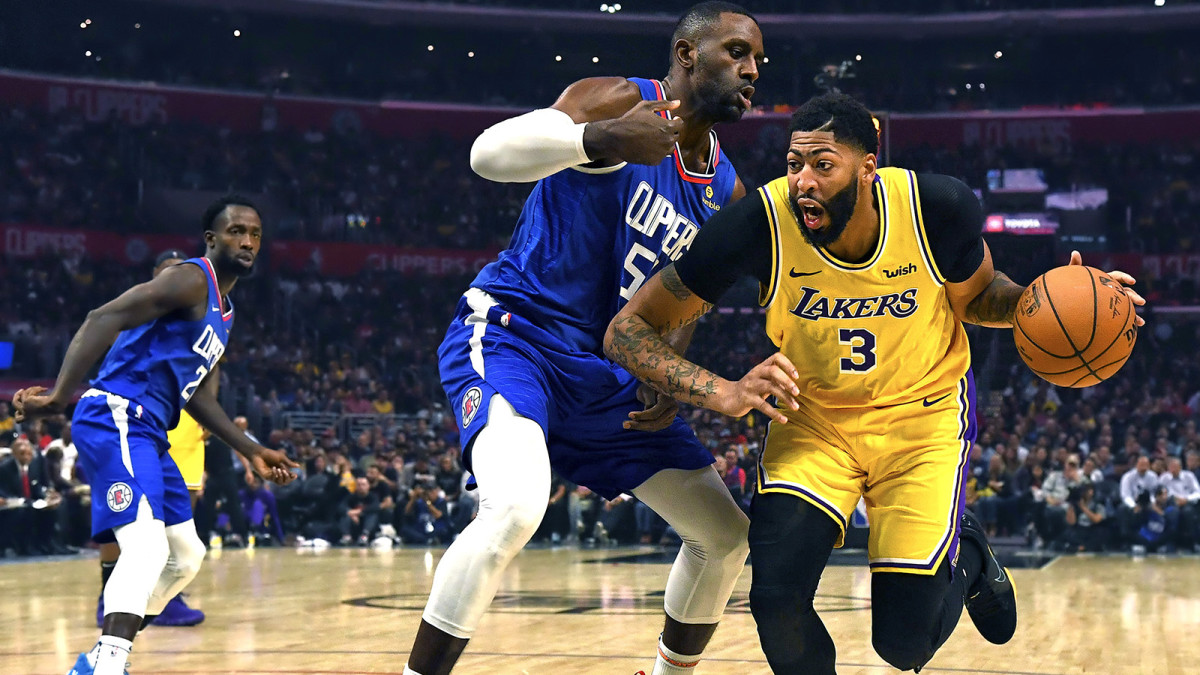
7. Anthony Davis, Los Angeles Lakers
While LeBron James was the unquestioned No. 1 on the Lakers, Anthony Davis was the key to unlocking the team’s success. His versatility, particularly on the defensive end on the floor, essentially served as a cheat code for the Lakers’ coaching staff. Frank Vogel could play big, small, shooters, non-shooters. Seemingly none of it mattered because Davis’s game largely covered up for any perceived deficiencies elsewhere in the lineup.
AD will be a bonafide Defensive Player of the Year candidate for many seasons to come. He shifted between power forward and center in 2020, and he was the ultimate eraser for the Lakers. Vogel could cook up aggressive schemes because Davis served as the ultimate backline defender, punishing those who dared to challenge him in the paint. The Lakers rarely relied on switching, and their stay-at-home mentality banked on the fact Davis could roam and wreak havoc when necessary. AD could also guard perimeter stars, like he did when he matched up with Jimmy Butler in the Finals, or Kawhi Leonard during the regular season. Only two or three players in the world right now are as impactful as Davis when he’s locked in on the defensive end, and frankly that skill alone makes him an incredibly valuable player.
But of course, there’s the offensive component. James recently told SI the Lakers thought Davis was hardly breaking a sweat at times when putting up monster numbers. AD’s game is effortless on the surface, but the devil is in the details, particularly his footwork. He can abuse more lumbering bigs with turnarounds, jab steps, and quick bursts. He can bully smaller defenders on the block. He looked like Dirk Nowitzki at times with his midrange jumper during the postseason. And Davis also has the ability to stretch his game out to the three-point line, though he’s so effective from the elbow down it almost seems unfair when he’s also connecting from distance.
Like many greats, Davis is obsessed with constantly adding flourishes to his game. He’s only 27 years old, which means the contract extension he recently inked will carry him through the smack dab of his prime. The players above Davis on this list have either been the No. 1 guy on a championship team or won MVP (or both.) The odds are AD will join that club sooner rather than later. — R.N
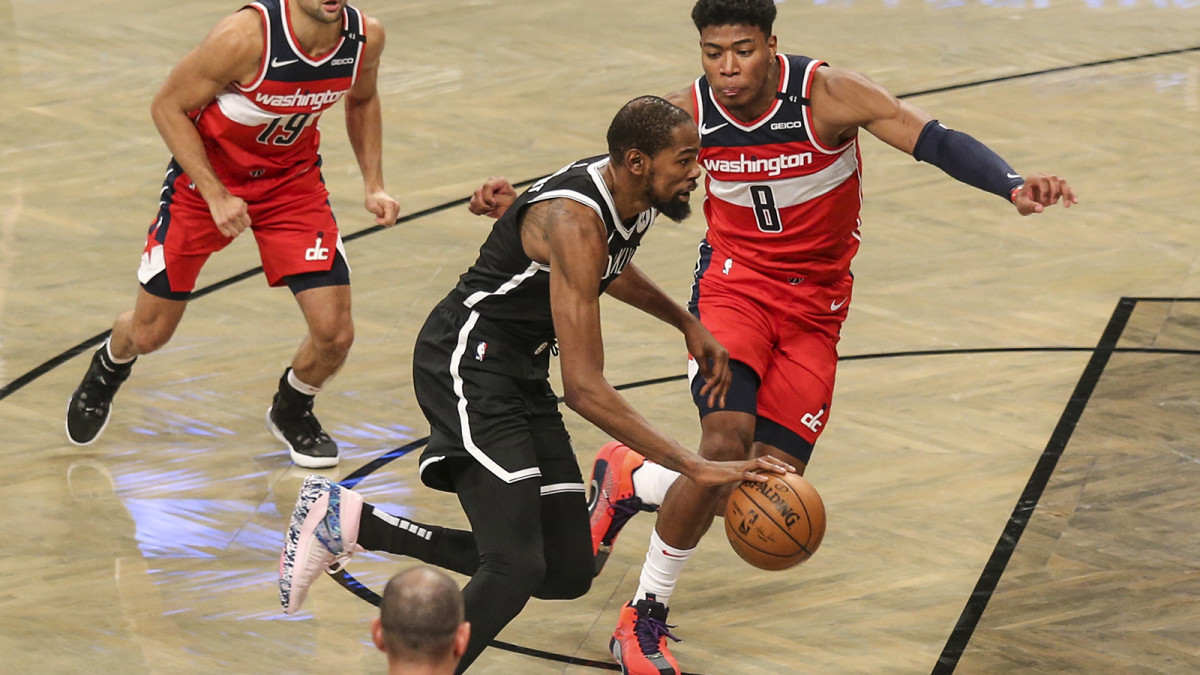
6. Kevin Durant, Brooklyn Nets
All signs would seem to indicate that we’re getting something close to the full Durant experience this season. He’s far enough removed from his torn Achilles that expectations are running high. There’s certainly some hope built into this ranking, but we’re talking about one of the greatest scorers in league history, and a player whose size, skill and pure shooting ability give him a chance to age more than gracefully as he plays out his remaining prime years in Brooklyn. Durant is one of maybe a handful of players who are true threats to score the ball no matter where they stand on the floor nor how you choose to defend them. He’s always been able to simply shoot over you when he wants to, and he makes those shots most of the time. The magic lies in the consistency and inevitability of those points, particularly when games matter most. His decision to join the Warriors will always be controversial, but the results he got in Golden State should not be. Now, Durant’s time with the Nets—the third phase of his career—may prove to be the most complicated test he’s faced.
So, what’s next? Durant has said he’ll spend time at center this season. Brooklyn’s apparent willingness to experiment, and his apparent lack of minutes restriction, bodes well for the state of his body. The truth is that he’s always transcended positions, because he’s seven feet tall and is probably going to score on whoever’s defending him. But the thought of him working more as a screener and the focal point of a five-out offense is certainly intriguing food for thought. As Durant continues to age, the value he brings defensively will continue to diminish. You might also see his playmaking skills and rebounding trend upward as his responsibilities change. Health is a serious caveat, but if we’re simply picking teams for this season, it’s hard to take Durant any lower than this. If he truly returns to form, this placement will look a little conservative. —J.W.
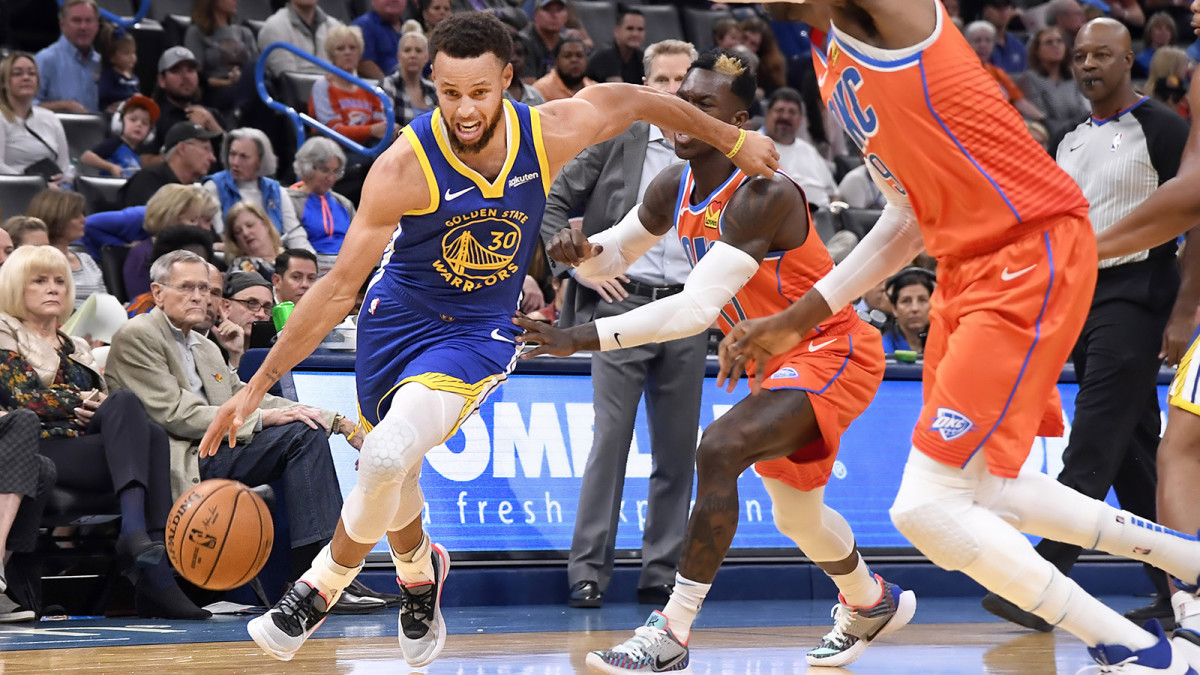
5. Stephen Curry, Golden State Warriors
For some reason, there’s a section of NBA fans who want to shovel dirt on Stephen Curry. They think he needs to prove something this upcoming season, that he has to show he can still be a superstar-level player without Klay Thompson or Kevin Durant by his side. It’s blasphemous. Curry remains one of the most electric players in the NBA, and his shooting ability endures as one of the most impactful forces in league history.
Curry played in only five games last season, but there’s no reason to believe he’s not fully recovered from the broken hand that caused him to miss most of the year. If anything, the long layoff should help Curry, whose body could have likely could have used a break after five straight Finals trips. Critics will point to Golden State’s early struggles in the first post-Durant year as evidence that Curry can’t be a traditional No. 1 guy. That strain of thought completely ignores the context of last year’s Warriors roster, which was hastily reassembled after Thompson’s ACL tear and Durant’s departure.
Just because Curry doesn’t have the build, look, or style of a typical perimeter star doesn’t mean he’s any less effective. His gravity alone on the offensive side of the ball completely changes the calculus of any defense. For as great as players like LeBron, KD, or Kawhi are, when have you ever seen an opponent try to slow them down with a box-and-one? Curry is obviously a killer with the ball in his hands because he’s a threat to pull up at any moment, but his off-ball work—his cutting, screening, and constant motion—is just as beautiful to watch. Few stars of his caliber are committed to that style of play. And the attention he draws when he sets a proper screen makes life immeasurably easier for his teammates. Curry could score 15 points in a game and still be the reason for an elite offensive performance because of everything he does for his team. And for all the concerns about his defense, he continues to compensate for his relative lack of size by being in the right place at the right time and an engaged team defender.
At 32, Curry may very well be nearing the end of his prime. Still, shooting often ages gracefully. And with all the chatter about his status as a No. 1 perhaps serving as extra motivation, Curry should be primed for at least one more great season. — R.N
4. James Harden, Houston Rockets
Strip away the aesthetic debate and a simple truth emerges regarding James Harden. Houston’s leading man is arguably the greatest scorer of the century, and at this point in his career, Harden remains a walking playoff berth. The 2017–18 MVP enters this season with 11 straight postseason appearances and three straight scoring titles, posting one of the most impressive scoring resumes in league history. Just three players have tallied more 40-point games. Harden could pass Kobe Bryant for the third-most 50-point performances this season, and he has a good shot of passing Michael Jordan for the No. 2 spot in the coming seasons. Harden does benefit from obscene volume, but can you really blame Houston for tailoring its offense to the Harden show? The past eight years have represented arguably the best stretch in franchise history thanks to Harden’s brilliance.
It’s not necessarily the scoring totals that makes the Harden experience so jarring. It’s the way he’s completely warped defenses in recent seasons. His dominant step-back has forced opponents to shade their coverage to a hilarious degree, placing defenders firmly on his left hip to prevent the game’s most unstoppable move. When one defender fails, defenses opt for a new strategy entirely. The 2019–20 season brought the emergence of the Harden trap, in which teams would double-team Harden before he even stepped past half-court. Harden has a legitimate statistical case as the greatest scorer of this century. But the way he’s defended may be the greatest testament to his greatness. Just as Michael Jordan required his own unique coverage decades ago, opponents fully embraced the Harden Rules to a shocking degree in 2019–20.
Harden’s offensive brilliance will earn him a bust in Springfield and potentially a statue in Houston when all is said and done. But will the Harden experience be remembered as much for its frustrations as its brilliance? Harden remains an imperfect player despite it all. He’s often unwilling to make any impact without the ball in his hands, far too content to rest with his hands on his hips in the half-court. Harden’s postseason failures have been noted ad nauseum, and while there is some context necessary, it’s hard to shake the feeling that there is a gear missing with the season on the line. Harden disappeared in a 2017 exit against San Antonio. He couldn’t stop the stream of missed triples vs. Golden State in 2018, and he was outdueled by Steph Curry down the stretch one year later. Perhaps Harden’s struggles are exacerbated by his unique style. Perhaps the talent around him is to blame. Regardless, Harden’s contention window in Houston appears to have come to a close. We’ll see if he can reverse his career narrative in a new location sooner than later. —M.S.
3. Kawhi Leonard, Los Angeles Clippers
On any given night, Kawhi Leonard can be the best basketball player in the universe. Though his first year with the Clippers ultimately ended in massive disappointment, Leonard showed numerous times throughout 2020 why some had moved him ahead of LeBron before the season. Kawhi is a steely assassin, an expert at getting to his spots when he needs a bucket. He’s at his most enjoyable to watch when he puts teams away by himself, going on these mini flurries at the ends of halves, forcing opponents into submission with his unstoppable elbow jumper. Leonard is a master at playing on his schedule. He can lull you into a false sense of confidence because at first glance his style of play is not overwhelming. But once he finds a weakness to exploit, he is ruthless in his execution.
With the Clips, Kawhi improved on the campaign that landed him a Finals MVP in Toronto. He averaged a career-best 27.1 points per game, shooting a robust 47% from the field and 37.8% from three. The defense remains suffocating when he wants it to be, even if Kawhi isn’t a pure stopper as he was early in his career. (Nobody with that much of an offensive burden really is.) Leonard also made great strides as a playmaker, recording a career-high 4.9 assists a night. Playing without a great point guard for really the first time in his career, the Clippers asked Leonard to be more of a ball-handler in 2020, and he acquitted himself well as a passer when drawing extra defenders. That added element to his game made the Clips really deadly when they had their full complement of players, as Kawhi was adept at finding his numerous shooters when needed. (If anything, the Clippers’ early playoff exit showed that Leonard could afford to be even more aggressive. Perhaps it’s not his preference, but he’s more than capable of running constant pick-and-rolls to exploit matchups.)
Ultimately, there’s a reason why Leonard, before the age of 30, has gotten the best of guys like Durant, Steph, LeBron, and Giannis in the playoffs—it’s because he’s really damn good. All the players listed there have also had disappointing playoff losses, by the way. Don’t let what happened in the bubble convince you that Leonard isn’t still on the level of the elite of the elite. — R.N
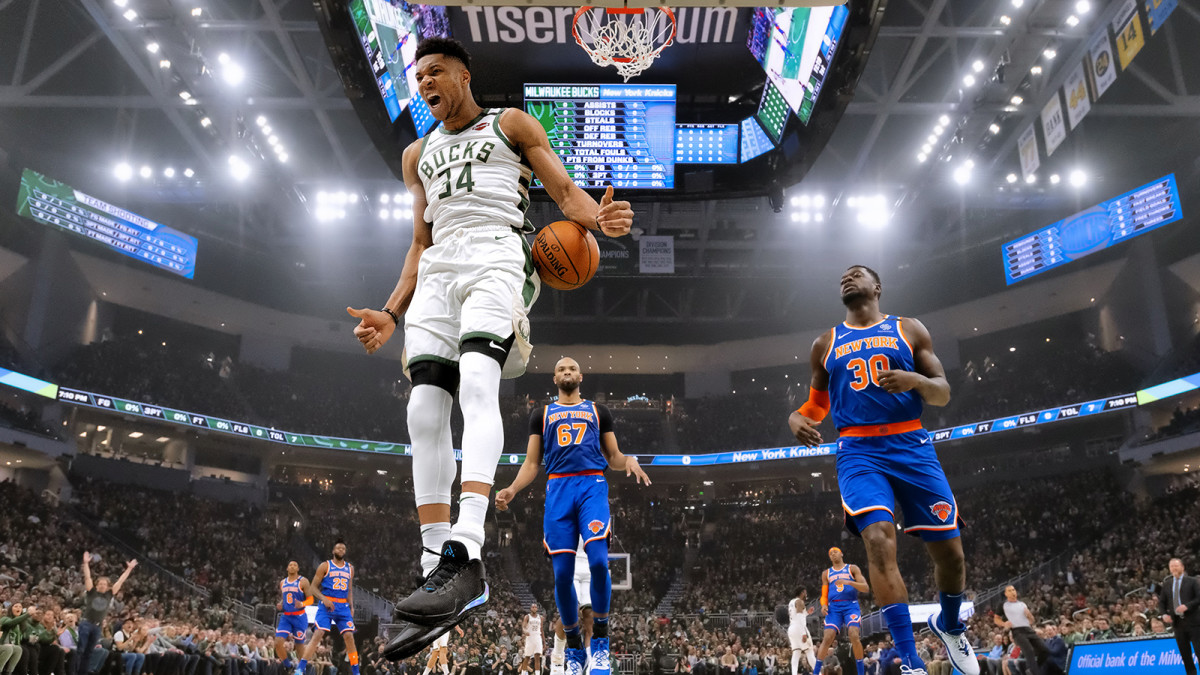
2. Giannis Antetokounmpo, Milwaukee Bucks
There’s no shame here in Giannis ceding the top spot on our list, and it may not take much for him to reclaim it. He offers more on a nightly basis than any player in the league. He’s a seven-foot-tall athletic marvel, and his ballyhooed quest to make the Finals cannot be held against him in an exercise like this. There may not be a player in the league, from stars to scrubs, who pours as much of himself into a given game than Antetokounmpo. Using his length, explosiveness and intelligence, he dominates the interior, he breeds transition offense, he finds teammates, and he wins games. There are games where his jumper doesn’t fall — the only true critique of his game at age 26 — but Antetokounmpo doesn’t take nights off. It is noteworthy that those shooting woes tend to manifest in the playoffs, when opponents wall off the paint and take their chances. The consecutive, unceremonious exits are blots on his ledger. But there is also room for improvement, and in the context of a player who so genuinely cares about being great, we should be optimistic that the jumper will come. (Plus, he’s pretty damn effective without it).
Antetokounmpo continues to improve each year, launching those threes more often than ever before, getting to the foul line more, rebounding better and making even more of his minutes, all while shouldering a league-high 37.5% usage rate in 2019–20. After all, this is the two-time reigning MVP and the Defensive Player of the Year. Where many of the league’s stars have plateaued in their 20s, Antetokounmpo continues to add wrinkles to his game. It will only continue to slow down for him. His production is the NBA’s most valuable constant. He comes in second here, only because arguably the greatest player in league history has yet to slow down in any meaningful way. So this is where we leave Giannis, as more 1B than true No. 2. —J.W.
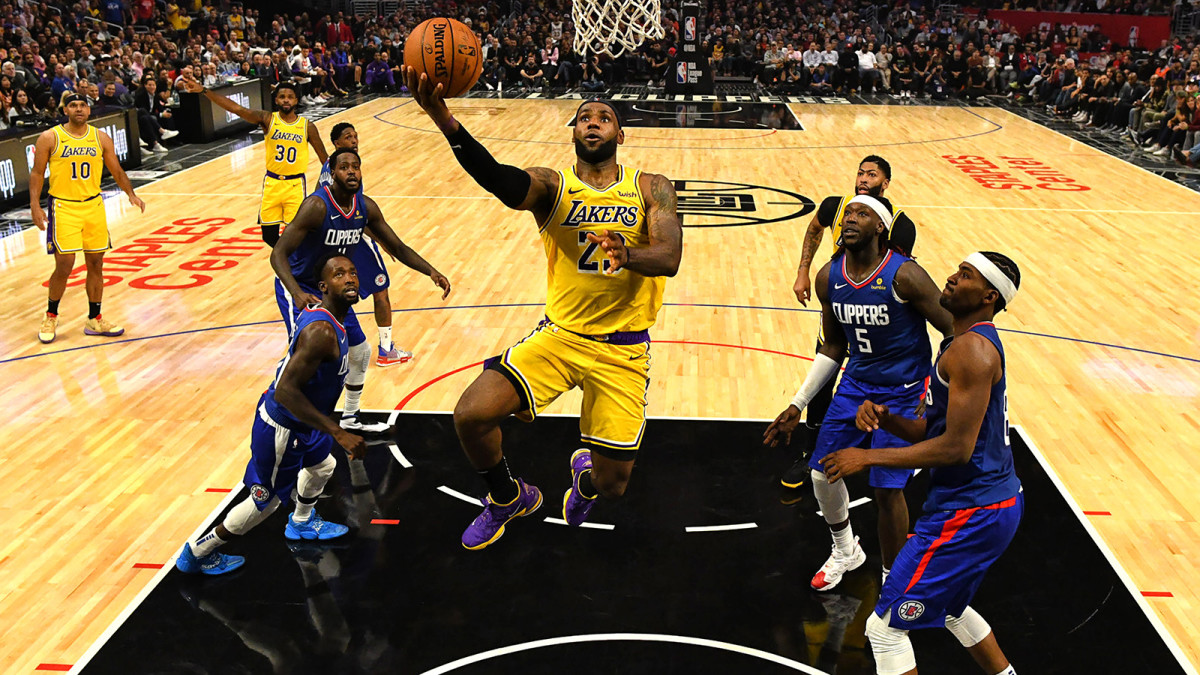
1. LeBron James, Los Angeles Lakers
It’s been 18 years of LeBron James, and we are spoiled. The King has now spent nearly half of his entire life in the NBA. He has little left to prove in terms of individual accolades or statistics. His sheer longevity speaks for itself. And after piloting the Lakers to a title, adjusting his game yet again to make it happen, he regains the top spot in this ranking after briefly ceding it a year ago. The mind-boggling amount of mileage on his body weighs on your mind, the half-step he’s lost athletically crops up time and again, and James can’t just flip the switch quite the way he used to. He requires maintenance and rest. He’ll take plays off defensively and weeks off mentally. At this point, these are things we have to simply accept. The meaty LeBron discourse can be picked clean from any angle. It can be exhausting. His case as the No. 1 player in an exercise like this no longer feels or reads as an absolute truth. Yet it remains the logical answer, knowing all that we know about who he is when the challenge boils down to winning or losing a game.
As last season reminded us, in any contest with stakes, there’s not another player you’d take ahead of James. He’s the best player on the planet when he wants to be. And when things matter, that’s always going to be what he wants. The Lakers are favorites to repeat for that reason. LeBron led the NBA in assists for the first time as a 35-year-old, and it didn’t happen by accident. That vision and wherewithal isn’t going to be what fails him. James still finds ways to swing the outcome of games in unexpected fashion. When there are great players around him, he doesn’t simply fit with them—he takes their play to another level. While still giving full credit to Anthony Davis, everyone knows that his on-court life has never been easier, with James on the floor to dictate where the ball should be, to draw defenses, and maximize the quality and ease of his shot attempts. The Lakers’ championship doesn’t happen without that level of synergy. It all still revolves around LeBron, in a way no other player can replicate. He’s proven that it will not be his brain or his skills that lead to his decline. It’s a different brand of dominance now, but the impact and the weight of his influence remain unmatched when things count. It’s all about the end result.
How much longer James will hold the top spot is anyone’s guess, and going into this season, there are plenty of comers. But it feels certain that this is not the time to take it from him. And that’s where we’ve landed. —J.W.
